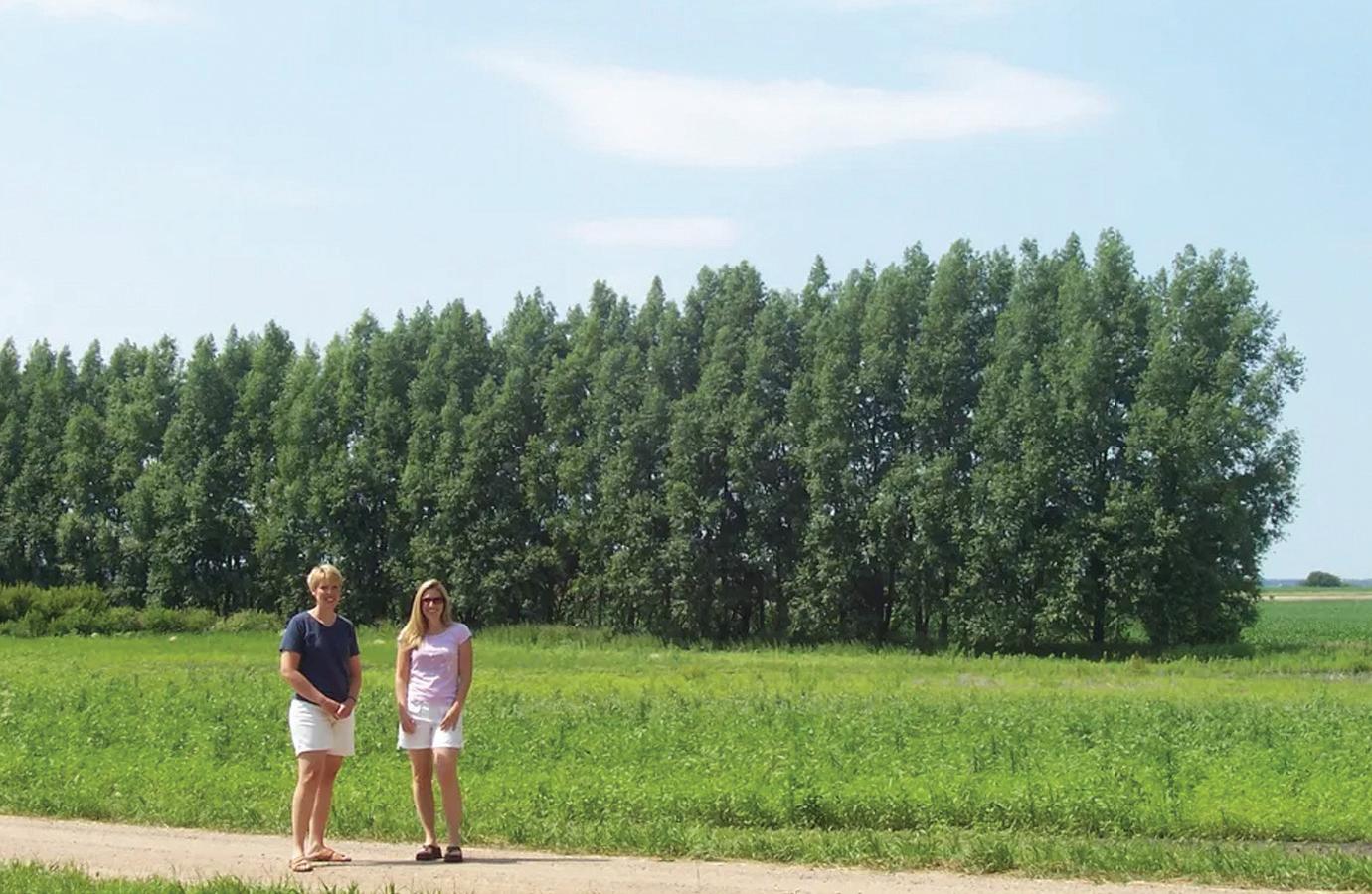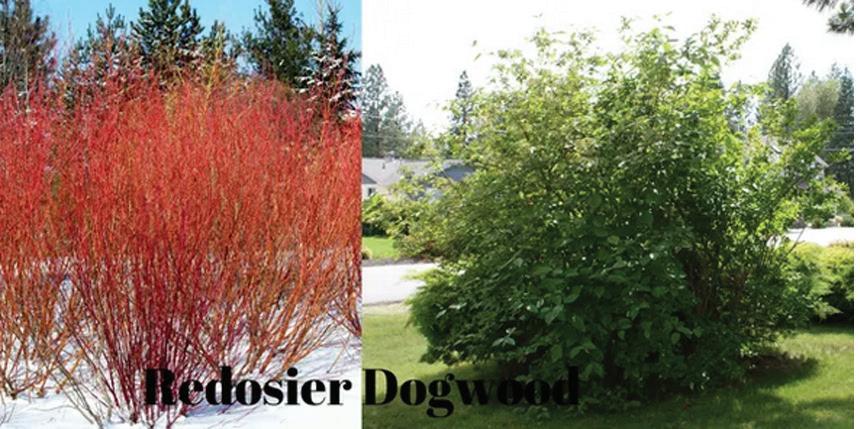




























































































When I was a kid, I mostly wanted to be one of two things when I grew up: an archaeologist and a writer. The truer of the dreams was to write; but a job title ending in “-ologist” sounded pretty important. Indiana Jones might have had something to do with it, too.
Since I grew up with a typewriter and not a computer, I had to turn to an actual book to learn more about what the occupation would require. My neighborhood friend was set on being an architect, and so we pulled out the “A” encyclopedia to find out what would be required of us in our future careers. We were both quickly dismayed to learn she wouldn’t just be drawing pictures of buildings and I wouldn’t just be digging in dirt. I’m guessing our next actions were climbing on our bikes, riding to the nearby park, and forgetting about growing up.
responsible for The Paw Print, our student body newspaper, as well as the yearbook. The writing I did in Journalism my senior year was the first I had ever shared. Without that nudge, it never would have happened.
It’s nothing new, but still deserves to be said: quality teachers are so, so important. It’s imperative for kids to have space aside from the rest of their lives, have new opportunities presented, be allowed to tiptoe or plunge into real world scenarios, and to receive encouragement along the way.
Publisher: Steve Jameson: sjameson@mankatofreepress.com
General Manager: Deb Petterson: dpetterson@TheLandOnline.com
Managing Editor: Paul Malchow: editor@TheLandOnline.com
Staff Writer: Laura Cole: lcole@TheLandOnline.com

Staff Writer Emeritus: Dick Hagen: rdhagen35@gmail.com
Advertising Representatives:
Dan McCargar: (507) 344-6379, dmccargar@thelandonline.com

Deb Petterson: dpetterson@TheLandOnline.com
Office/Advertising Assistants:
Joan Compart: theland@TheLandOnline.com
Lyuda Shevtsov: auctions@thelandonline.com
For Customer Service Concerns:
(507) 345-4523, (800) 657-4665, theland@TheLandOnline.com
Fax: (507) 345-1027
For Editorial Concerns or Story Ideas:
(507) 344-6342, (800) 657-4665, editor@TheLandOnline.com
Because of the nature of articles appearing in The Land, product or business names may be included to provide clarity. This does not constitute an endorsement of any product or business. Opinions and viewpoints expressed in editorials or by news sources are not necessarily those of the management.
The Publisher shall not be liable for slight changes or typographical errors that do not lessen the value of an advertisement. The Publisher’s liability for other errors or omissions in connection with an advertisement is strictly limited to publication of the advertisement in any subsequent issue or the refund of any monies paid for the advertisement.
Classified Advertising: $21.99 for seven (7) lines for a private classified, each additional line is $1.40; $26.89 for business classifieds, each additional line is $1.40. Classified ads accepted by mail or by phone with VISA, MasterCard, Discover or American Express. Classified ads can also be sent by e-mail to theland@TheLandOnline.com. Mail classified ads to The Land, 418 South Second St., Mankato, MN 56001. Please include credit card number, expiration date and your postal address with ads sent on either mail version. Classified ads may also be called into (800) 657-4665. Deadline for classified ads is 5 pm on the Friday prior to publication date, with holiday exceptions. Distributed to farmers in all Minnesota counties and northern Iowa, as well as on The Land’s website. Each classified ad is separately copyrighted by The Land. Reproduction without permission is strictly prohibited.
Subscription and Distribution: Free to farmers and agribusinesses in Minnesota and northern Iowa. $49 per year for non-farmers and people outside the service area. The Land (USPS 392470) Copyright © 2023 by The Free Press Media is published biweekly by The Free Press, 418 S 2nd Street, Mankato, MN 56001-3727. Business and Editorial Offices: 418 S. 2nd Street, Mankato, MN 56001-3727, Accounting and Circulation Offices: Steve Jameson, 418 S 2nd Street, Mankato, MN 56001-3727. Call (507) 345-4523 to subscribe. Periodicals postage paid at Mankato, MN.
Postmaster and Change of Address: Send address changes to The Land, 418 South Second St., Mankato MN 56001-3727 or e-mail to theland@ TheLandOnline.com.

As time went on, the archaeology thing faded, and my handwritten stories about finding hidden treasure were replaced by teenage angst poetry and way too dramatic short stories, always tucked safely away.
It’s never just academics that’s going on in high school. It’s also dealing with friends, non-friends, once friends but no longer, relationships, break-ups, self-discovery. It can be a lot. I stayed in a dorm Sunday night through Friday afternoon, so the act of figuring life out often felt like a full-time spotlight situation. At my school, teachers could select from pre-written remarks to add to report cards. One of my more consistent comments received my freshman and sophomore years was something along the lines of “more interested in her social life than academic learning.” I failed, among other things, to see a problem.
At the time, Mrs. Jaeger was the junior and senior literature teacher. Once I became an upperclassmen, her classes quickly became my favorite. She was calm, steady, reliable — not too affected by teenage antics. Every once in a while she’d make a joke or laugh at one of ours. She had the gift of being able to establish and maintain order in a relaxed environment. Her husband was also a teacher at my school and had very similar traits. But he taught math, and so those 50 minutes just weren’t as close to my heart.
Both Mr. and Mrs. Jaeger played a part in me gaining an improved outlook on education as well as becoming a little more well-balanced of an individual. I’ve kept many of my papers from Mrs. Jaeger’s classes. One includes a note encouraging me to consider joining her Journalism class. That class was
A teacher’s approach will resonate differently with each student. No one’s a mind reader and no matter how hard a teacher tries, they might not be able to get the delivery right every time for every kid. But kindness, encouragement, positivity, and presence can fill the gaps. And when a connection is made, it has a lasting effect.
I recently had the pleasure of speaking with the six Minnesota State FFA officers from 1997-98. Within this issue, you’ll be able to read about their FFA experiences and what they’re up to now.
My first conversation was with Jill Grams, who spoke so highly of her ag teacher/FFA advisor and the encouragement he gave her. It was amazing to hear. My next talk was with Natasha Mortenson, and she shared similar sentiments about her own ag teacher being encouraging and someone she looked up to. By the time I had finished the last interview, I was sincerely impressed to have heard such praise and admiration for the officers’ ag teachers and mentors. It’s clear these teachers both followed and taught the FFA motto of Learning to Do, Doing to Learn, Earning to Live, Living to Serve.
FFA had not been offered at my high school and I didn’t grow up knowing much about the organization. Learning that FFA is not only about farming left me feeling a bit like the Grinch realizing that Christmas doesn’t just come from a store. Instilling values, life lessons, and trust — along with providing occasions to maybe flounder but also succeed — are all so vital for youth.
Special thanks to the ag teachers of this state officer team: Mr. Yusten, Mr. Erickson, Mr. Larson, Mr. Swanson, Mr. Hermanson, Mr. Rambow, and Mr. Rick.
To all of the teachers, mentors, and encouragers: your unending efforts are appreciated. Thank you!
Laura Cole is the staff writer of The Land. She may be reached at lcole@TheLandOnline.com. ❖

Nearly drowned out in all the farm group cheering that U.S. ag exports hit a record high $196 billion last year was the inarguable fact that U.S. ag imports also hit a record-high, $199 billion — or $3 billion more than ag exports.
That’s right, sports fans: during its biggest ag export year ever — when the value of American ag exports grew an astonishing $19.5 billion, or 11 percent, over 2021 — the value of U.S. ag imports grew by $28 billion, or 16 percent.
By Alan GuebertAll that farm and food outflow and even more farm and food inflow is a hallmark of ever-changing global markets. Caught in that change is America’s fading dominance of world ag markets — markets which yielded a $17 billion surplus as recently as 2017.


Now, however, it’s ag trade deficits and none are going away anytime soon.
On Feb. 23, the U.S. Department of Agriculture estimated the Fiscal Year 2023 U.S. ag trade deficit will balloon to a wide $14.5 billion as American ag exports fall to $184.5 billion and ag imports remain at $199 billion.
If accurate (the trade numbers will be updated May 31), two eye-watering facts leap out. First, FY 2023 will post the largest ag trade deficit since at least 1959; and second, 2023’s forecast means U.S. ag will have run trade deficits in four of the last five years.
Few, if any, American farmers have witnessed a similar run of export red ink.
Part of the U.S. shift to trade deficits swings on 2022’s strong commodity prices tied to both the UkrainianRussian war and global weather woes; and the export slowdown those steep, volatile prices caused global buyers.
For example, notes the American Farm Bureau Federation in a recent Market Intel report, “(E)xport value across all products [in 2022] increased by 11 percent year-over-year, but export volume actually declined by 6
Still, that same AFBF analysis showed “In 2022, U.S. exports remained concentrated in the top six markets. Sixty-seven percent of U.S. ag exports were to China ($38.2 billion), Mexico ($28.5 billion), Canada ($28.3 billion), Japan ($14.6 billion), EU-27 ($12.3 billion) and South Korea ($9.5 billion).”
Like trade itself, however, those big players aren’t static. That’s especially true for China — our biggest, richest ag customer, suggests a recent article by the Council on Foreign Relations.
Even while “China ranks first globally in producing cereals (such as corn, wheat, and rice), fruit, vegetables, meat, poultry, eggs, and fishery products,” CFR explains, it will continue to import ag commodities like soybeans whose “cost to grow … in China is 1.3 times than it is in the United States, and the yield is 60 percent less.”
Which is exactly what happened in 2022. China’s imports of U.S. soybeans were up 8 percent by volume last year; but its corn import volumes dropped 16 percent and wheat fell 13 percent. That may become a trend, foresees CFR, as China seeks “to diversify its import sources… In 2021, Brazil replaced the United States as China’s largest agricultural supplier, providing 20 percent of China’s agricultural imports.”
Other observers agree.
In a cold-eyed analysis of recent trade patterns between China and the United States, the Peterson Institute for International Economics (Peterson) says the die was cast when “U.S. exports to China … cratered during President Donald Trump’s trade war of 2018-19” and now “are continuing to suffer.”
Farmers and policy makers should take heed, because Peterson is not some lily-livered, lefty anti-trade hothouse. It is, in fact, the direct opposite.
You can always tell.
It’s either a road grime-colored vehicle or dress pants which have that tell-tale mark about calf-high that tattles on someone whose path to church involved a gravel road or two.
Whether or not you live on a gravel road, it’s hard to avoid them. But if you do, you learn clotheslines are only useful on days when manure hauling is not on the docket, or on days with gale-force winds which leave clothes dirtier than they were before they were washed.
By Karen SchwallerThere is a lot that happens on gravel roads. They are places where kids grow up in lots of ways: driver’s education class for eight- and nine-year-olds; driving that semi for the first time under Dad’s watchful eye; learning how to handle a loaded hayrack or water tank for the long haul; tractor and implement operating lessons; school bus pick-ups and drop-offs; and they even offer a walking trail for reasons of fitness, spiritual healing and escape.
Athletes are made in farm fields. There is no need
to go to the gym when a kid spends a summer stacking square bales, building strength and endurance. I have also walked about a billion miles on our gravel roads — sometimes drowning in a cloud of road dust. I’m certain the medical community will someday be treating something called, “Walker’s Lung.”
Farm fields are places where dreams come true for young and old, and offer a place for a farm mother to spend time with her children once they’re old enough to help with the field work. It’s the only time she’ll see them — especially as teenagers and young adults.
My sister and I developed a strong sister-bond on the gravel road by our house, as we would walk that half-mile to the corner, then sit and throw rocks at a pole for target practice while we discussed the hot topics of the day at school. There was a creek and bridge not far from our driveway which also served as great entertainment for all of us kids in all four seasons.
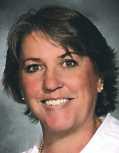

There was (and still is) the art of rock collecting which I learned from my grandmother who first introduced me to the word “interesting” as it pertained to rocks on our gravel road. I had never really noticed them before she helped us know that rocks are little chunks of art.
There are martial-art conquests with wasps in mailboxes that happen on gravel roads … some of the most entertaining dancing you’ll ever see. And gravel roads can be places of complete tranquility and a little slice of Americana — until the hogs get out.
When that happens, farm families understand Shakespeare’s winter of discontent.
Terrible things happen along gravel roads, too. A bus accident took the life of a 15-year-old young man near our childhood home — right after we had gotten off the bus after school. The gravel road taught me that day we don’t all get a chance to grow old. They are farm-to-market roads and places which allow us to get to and from our fields and the eleva-


When you were in school, you thought that was all there was to history: dates and battles. So why not change your own mind this spring with one of these great new books about the hidden histories of World War II?
By definition, a World War means that nearly the whole world was involved; but in “Hitler’s Aristocrats” by Susan Ronald (St. Martin’s Press, $32.50), you’ll read another part of the story not often presented. Ronald pulls the covers back on the elite civilians, wealthy donors, royal influencers, and non-military business leaders who quietly helped Hitler and the Nazis. But these behind-thescreen forces, those friendly to the Fuhrer, came from surprising places. Some of these names will shock and surprise you, making this a book for every World War II buff’s bookcase.
By Terri Schlichenmeyerc.2022, 2023, various publishers
$28.00 - $32.50
various page counts
Imagine how the war would might’ve ended without every single one of its Allies in control. In “The Nazi Conspiracy: The Secret Plot to Kill Roosevelt, Stalin, and Churchill” by Brad Meltzer and Josh Mensch (Flatiron Books, $29.99), you’ll read about a chilling plan that, if it had come to fruition, could have altered the world forever. True story: when the Nazis learned Franklin Roosevelt was planning on a meeting to discuss the War’s strategies with Churchill and Stalin in Tehran in 1943, Hitler’s men began to hatch a plan of their own. It involved not just one, but three assassinations they hoped would alter the course of the War. That might sound like the plot of a novel, but this tale is true and told only as Meltzer and Mensch can tell it. Yes, it’s a history book; but fans of fictional thrillers will eat this up.

And finally, a book begins before the War and then takes readers past it...
In “The Confidante” by Christopher C. Gorham (Citadel Press, $28.00), you’ll read about the life of a woman history has largely ignored. Her name was Anna Marie Rosenberg and she was a PR person in
Manhattan in the Jazz Age when she became friends with Eleanor Roosevelt — who was not yet then a First Lady.
Mrs. Roosevelt later urged her husband, the President, to hire Rosenberg — and he did, which was a good call since she was the right person for the job of special envoy for FDR during World War II. After the War, Rosenberg continued to work in Washington and she held considerable power (though, officially, she couldn’t). She rubbed elbows with the famous and infamous. She had the ear of some very influential men in America over the course of decades.
Some of the issues at the heart of politics today were on Rosenberg’s mind and if you follow current events, then you need to know this book.
Not enough for you? Then you need to seek out your favorite bookseller or librarian, who is a topnotch ace at finding the right book for you. In the meantime, grab one of these books and make a date with your easy-chair.
The Bookworm is Terri Schlichenmeyer. Terri has been reading since she was 3 years old and never goes anywhere without a book. She lives in Wisconsin with three dogs and 10,000 books. v
When my farmer and I were discussing which livestock we wanted on the pasture, we did consider mules. Perhaps we were beginning to realize we have become like two old stubborn mules; or we are thinking it is time to consider trading my bicycle for something that took less exertion.
For many reasons, mules are appealing. They have proven useful on the farm, in the freighting business and with the U.S. Army. Horses receive a great deal of glory (which is deserving); but the mule also has its place.


one time, the state — which is sometimes referred to as the “Mother of the West” — was the largest mule-producing state in the union.
It definitely was the birthplace for the American/Missouri mule.
The famous Santa Fe Trail also had its beginning at Franklin. It was started as a commercial trail.

were carrying $2,600,000 in gold. There were 500 armed guards and homeward-bound miners on this trip. What a picture that would make!
There are plenty of good reasons why mule trains are a symbol of the old west.
the desert spaced an average of 16 miles apart, which was considered a day’s journey.
The parentage of a mule would always be a question I would fail to answer correctly if it were on a test; but a mule is a cross between a Jack (a male donkey) and a mare (female horse). But guess what? I looked into two different encyclopedias and the one reversed the parentage … so no wonder I am confused.
The mule would know, as this cross produces a superior animal with great intelligence.
The mule was introduced to America by Stephen Cooper in 1823, according to the book “Saga of Old Western Travel and Transport” by Wilbur Hoffman. Mules had been used in Old Mexico for a long time.
He explains that Mr. Cooper had purchased 400 mules, jennets (a female donkey) and Spanish jacks while on a Santa Fe trading expedition.
Cooper took these mules back to his home near Franklin, Mo. He probably raised a few eyebrows when these animals appeared on his farm. But when these jacks sired the first ‘Missouri Mules,’ and his neighbors saw the practicality of these animals, they soon began raising their own stock. At
William Becknell, a trader and War of 1812 veteran, decided to expand his business with trade to Mexico. In September of 1821 (the same year Missouri was admitted to the Union), he left his home town of Franklin with a caravan of freight wagons loaded with cargo. Mules provided the draft power.
His destination was Santa Fe, which at the time was in Mexico.
Mexico had recently gained its freedom from Spain. While under Spanish control, it had been a closed empire. Now the country was open to trade and anxious for it.
Several months later, after miles of rough travel, Becknell’s caravan arrived at Santa Fe on Nov. 16. The trip was successful and they were greatly encouraged by the people in Mexico to come again — which, of course, Beckwell did. By listening to others and trying new ways, he perfected the route for better travel.
Freighting — despite the hardship and danger — was appealing as it was very lucrative. Mules were well-suited for this work. Cooper took the initiative and risk to bring breeding stock back to Missouri.
Mules not only proved their usefulness on the Sante Fe Trail, but also during the California gold rush of 1849. They brought supplies to remote regions and packed out the diggings. On one convoy, nearly 1,000 mules
Probably the most famous mule train is the one still barely pictured on the Twenty Mule Train Borax box. The book gives an excellent description of the work and dangers of freighting Borax 164 miles through the desert where temperatures soared over 130 F in the shade (if there had been any shade on the Death Valley Trail).
The trail was appropriately named as nothing really grew there and watering spots were separated by 20 to even 60 miles of desert.
The wagons pulled by the 20-mule trains were huge. They would weigh 7,800 pounds empty and could carry 22,500 pounds of cargo. It’s no wonder it took a train of 20 mules to pull one wagon. A round trip was usually 20 days long.
They had to be quite self-sufficient. The life-saving 1,000-gallon iron water tank was mounted to a standard wagon gear. On the trip to the Borax mines, the wagons carried hay and grain. These supplies were left out on
This whole history is rather interesting — especially when you consider the proficiency of the teamster who managed the 20 mules with a jerk on the reins. The skill required to keep the train under control and take corners at the speed they travel is admirable and something to marvel about.
The pay was $120 per month for the muleskinner and $80 for the swamper. This was thought to be good money — especially as there were no places to spend it while on the trail. In between trips, the crew were only given an afternoon off before embarking on the next trip for Borax.
Mules are very intelligent with an excellent memory. It’s rather important to have a patient, kind trainer — a worthy attribute for every livestock owner and parent.
What I especially liked about mules was that they require less forage than a horse and do not overeat. Perhaps that mule could teach me a thing or two.
I’m not making this next statement up. It can be found in the 1934 edition of “The World Book Encyclopedia.”

Spring has technically been here for a while. (It depends, of course, which definition of spring one uses.) But it is now beginning to feel like spring. In celebration of the positive, this month’s column is about the University of Minnesota Medical School’s work to train primary care physicians for Minnesota and particularly for the non-metro parts of our state.
In 1971, the medical school launched a program to place third-year medical students in rural communities for part of their training. The medical students live, work and study in these communities for nine months. The program is called the Rural Physician Associate Program (RPAP).
By Mark Brakketicipated. Two out of three of this group practice medicine in Minnesota. Seventyfive percent are primary care physicians. Forty percent practice in rural areas. That is a successful program.
I had the pleasure of recently talking to Dr. Adrianne Moen who practices in Staples, Minn. She personally participated in the RPAP program and now lives and practices in Staples. The hospital and clinic she works at currently host two RPAP students each year. She recalls her rural healthcare experience as a student as being very positive.
sicians in Minnesota and the United States, so this increase in physician supply is much needed. We can be thankful the University of Minnesota Medical School is responding to this need. It is worth mentioning the University of Minnesota Medical School’s program for training primary care physicians (family practice physicians, pediatricians, obstetrician/gynecologists, internists) is ranked as one of the best in the country.
Most of us recognize involvement in a community is a positive experience. The medical students get to meet patients, nurses, hospital and clinic staff, community members and local doctors. It is an opportunity for those students to become enthusiastic about the option of practicing medicine in a non-metro location.
Since 1971, over 1,700 medical students have par-
Another recent development from our University Medical School will be very positive for rural Minnesota. A new medical school campus will open in St Cloud and have a class size of 80.
Currently, the Minneapolis campus has 175 students per year and the Duluth campus has 65 students per year. Fifty-five students at the Minnesota Mayo Medical School makes a total of 295 medical students per year. Adding another 80 in St Cloud will be a 27 percent increase.
There is currently a shortage of primary care phy-

Recalling that we live in a democracy and the government needs our input to make good decisions, consider contacting your Minnesota senator, representative and the governor and let them know you appreciate their commitment to making healthcare work in outstate Minnesota. Just as it is said it takes a village to raise a child, it takes a community to raise a doctor.
Best wishes to all of you for a fine spring. Mark Brakke is a retired family practice physician. He cared for patients in Coon Rapids, Minn. for 41 years during which time he was on the boards of directors of two health insurance companies. He currently is on the board of the educational non profit Health Care for All Minnesota (HCA-MN.org).
Visit www.TheLandOnline.com to view our complete calendar and enter your own events, or send an e-mail with your event’s details to editor@thelandonline.com.
April 1 — Gardening Education Day — Hutchinson, Minn. — The day will include guest speakers, vendors, a silent auction, door prizes, and access to horticultural resources. Contact the McLeod County Extension office at (320) 484-4302.
April 1 — Gardening in the Driftless — Houston, Minn. — The annual Spring Days event will include morning and afternoon keynote speakers as well as a variety of breakout sessions taught by local experts. Attendees will also have the opportunity to visit vendor booths, bid on silent auction items and shop at the country store. Contact Houston County Extension at (507) 725-5807.
April 10 — Navigating Business Resources with the Help of Your Local Business Incubator — Online — Learn about how local business incubators can help your food business navigate business resources. Contact Jessica Jane Spayde at spayde@ wisc.edu.
April 11-13 — Dairy Calf & Heifer Association Annual Conference — Prior Lake, Minn. — The conference will include three speakers, Ross Bernstein, Dave Kuehnel, and Peggy Coffeen. There will also be a trade show with approximately 50 companies highlighting their calf and heifer products. Visit their website for more information at calfandheifer.org.
April 11-13 — PEAK 2023 — Minneapolis, Minn.
— Formerly called the Midwest Poultry Federation Convention, PEAK is the nation’s largest trade show and convention in North America focused exclusively on the business and food production of poultry. Contact Lara Durben at ldurben@midwestpoultry.com or (763) 284-6763.
April 12 — International Dairy Federation Webinar
— Online — The IDF will offer a technical webinar to share some of the main takeaways of the recently published Global Marketing Trends report. Visit their website for more information at fil-idf.org.
April 12 — Women’s Ag Leadership Conference
— Chaska, Minn. — The conference will begin with a welcome session, followed by roundtable discussions. There will also be mini-sessions focused on current topics, two breakout sessions, and an optional historic Red Barn self-guided tour. Contact Doris Mold at doris@ sunriseag.net or (612) 414-7574.
April 13 — How to Bring Skilled Professionals to Your Farm Using the Visa Programs Webinar — Online — Miguel Rangel, DVM will discuss the process of using the U.S. visa programs to bring skilled professionals to U.S. dairy operations from foreign countries. Information provided will include the application process, rights and responsibilities of employers and employees, and clarification of common misconceptions. Iowa Contact: Fred Hall, (712) 737-4230 or Minnesota Contact: Jim Salfer, (320) 203-6093.
April 14 — Things to Think about when Planning a Timber Sale — Online — Join University of Minnesota Extension foresters to discuss a key issue facing woodland owners in Minnesota. Contact Gary Wyatt at wyatt@umn.edu.
April 17 — Spring Gardening Seminar — Sauk Rapids, Minn. — This event will include horticulture topics, and is open to all gardening enthusiasts. The workshop will include two sessions: “Soil, starting from the ground up” and “Going ‘No-Till’ with your garden 2.0.” Visit http://z.umn.edu/SpringSeminar2023 for more information.
April 21 — Strategies to keep your woods healthy and resilient — Online — Join University of Minnesota Extension foresters to discuss a key issue facing woodland owners in Minnesota. Contact Gary Wyatt at wyatt@umn.edu.
April 28 — 2023 Participatory Science: Spotted Lanternfly, Mock Strawberry, Garlic Mustard Aphids — Online — Join University of Minnesota Extension foresters to discuss woodland topics. Contact Gary Wyatt at wyatt@umn.edu.
April 29 — Minnesota River Valley Master Gardeners Spring Workshop — Mankato, Minn. — Sessions include Tips for Growing Tomatoes, Trees and Shrubs for a Changing Climate, and Discovering the Beauty of Usefulness of Native Plants. Contact U of M Extension Office for Blue Earth County at (507) 304-4325.
FARMHOUSE KITCHEN, from pg. 5

“Mules inherit from their jack fathers the faculty of saving themselves when forced to work hard and for a long time and they are therefore less likely to suffer from overwork than horses.” Hmm…
Since I have a tendency to be timid, it’s nice that mules are generally smaller than horses — although they come in a variety of sizes. They will plod along at a steady, less fatiguing pace and can work in heat. To me that means when it is too hot to work, a trail ride on a mule would be the perfect way to spend a summer day.
We would have had to have a small pack of mules, as I am inclined to over-pack — even for an overnight trip. So by my estimate, we would need four mules. One for each of us to ride and two to carry my camping gear.
Cooper was on to something when he introduced the mule to America. Who knows? Maybe someday we will add mules to our farm. It would be rather
pleasant to hear the mules braying (which apparently also comes from the father). At this point, it is barely an idea. So my mule time is better spent listening to the stories of other people who know mules — such as this one from a friend. The true tale takes place in Wyoming.
Work was well underway at the Wheeler Ranch as Mr. Wheeler and his outfitters planned to guide another hunting expedition into the Teton Mountains.
Each planned hunt went deep into the wilderness into areas that were only accessible on foot or a pack train of horses or mules. On this particular trip, Wheeler was utilizing mules.
Mules can work quite well in rough terrain, as they are surefooted, tend to follow a leader and can carry a goodsized load, which comes in handy if the hunt is successful. The one drawback is that each mule usually has a contrary trait.
In the case of Sebastian (not the mule’s real name, but since this is
GUEBERT, from pg. 3
One columnist called it the “locker room of Team Globalization and Free Trade cheering squad.”
But this cheerleader can find no good news in the trading relationship that, in 2020, signed a “Phase One” deal which committed China to purchase an additional $200 billion of U.S. goods and services. “In the end, China bought none of the extra $200 billion...”
As such, today’s facts and tomorrow’s forecasts suggest ag trade deficits — not surpluses — may be the new normal.
The Farm and Food File is published weekly through the United States and Canada. Past columns, events and contact information are posted at www. farmandfoodfile.com.
based on a true story that was told me, it’s best to give the mule a different name. According to baby name books, Sebastian means ‘venerable’ or ‘honorable’. As you will see, the name fits.)
In the case of Sebastian, his peculiar trait was he liked to sit down once the pack was secure on his back.
One of the paying guests had brought with him a rare vintage of wine which had been processed at a vineyard in California. He was planning to share it with the others as they sat around the campfire at night discussing important matters. Now this just so happened to be in the pack that Sebastian was carrying.
Despite the many admonitions not to sit down, about 15 minutes after the pack was snugged up, wouldn’t
you know it? Sebastian decided it was time to rest his legs. In the stillness of the early morn, that moment when all is peaceful and calm, just before the sun breaks through the darkness, everyone heard the sound of glass breaking. Hence, in my opinion, Sebastian could be called the temperance mule.
By the way, “The Science of Animal Husbandry” by James Blakely and David H. Bade states the mule was first popularized by George Washington who had received a jack as a gift in 1787 as a gift of the king of Spain. In time, Mount Vernon had some top quality mules.
Renae B. Vander Schaaf is an independent writer, author and speaker. Contact her at (605) 530-0017 or agripen@live.com. v
HAMPTON, Iowa – In order to help producers and custom operators examine the custom farming service market, Iowa State University Extension and Outreach publishes the Iowa Farm Custom Rate Survey.
This year’s survey, published in March, includes 94 responses and 2,621 custom rates for tasks related to tillage, planting and seeding, spraying, harvesting, farm labor and more. Additions to the survey for 2023 include ground (broadcast) spraying with a selfpropelled, tall-crop sprayer and liquid fertilizer high clearance application with drop hose and Y spray nozzle.
Most custom rates saw an increase of 10-15 percent. Custom planting ranges from $12.50 to $45 per acre, depending on the type of planter and setup. Combining corn shows an average of $41.30 per acre and combining soybeans averages $39.90 per acre, an increase of 12.4 percent and 10.7 percent, respectively. Table 1 shows historical prices for select operations.
This year’s publication — as well as previous reports — can be found at https://www.extension. iastate.edu/agdm/crops/html/a3-10.html.
The survey may lag increases in diesel prices and other inputs that change more frequently. This means that for custom farming practices which involve these inputs, the cost may be even higher.
Source: Iowa State University Extension and Outreach, Iowa farm custom rate surveys, FM1698
The current survey assumed diesel prices would be $3.39 a gallon in 2023, based on forecasts from the U.S. Energy Information Administration.
The information in the survey is meant to be a starting point for farmers and agribusiness to engage in conversations and negotiations. The survey is not meant to set the rate for a particular practice or operator. This is an opinion survey and represents the responses of participants.
If you wish to join the survey list for 2024, email
Extension Economist Alejandro Plastina at plastina@iastate.edu, or Ann Johanns at aholste@iastate. edu
This article was submitted by Iowa State University Extension and Outreach.
TABLE TALK, from pg. 4
tors. They bring neighbors together for fun, help and in times of need. They can bring an ambulance and a fire truck, which also brings neighbors together ahead of that billowing cloud of gravel road dust.
They are places where farmers gather to discuss the day’s grain and livestock markets and weather, and where they rubberneck to evaluate someone else’s crops, compile and orate their commentary and analysis, and note that someone got a new tractor or truck … all while Mrs. Farmer wipes the drool which fell out while she napped during much of that process.
Gravel roads can become cow paths in the spring — necessitating four-wheel-drive or horse travel to get to work — and can be dangerously dry and dusty in the summer.
But mostly, a gravel road for many is the road home. When I left home, trips back would lead me over a hill, where I could finally see the white barn that told me I was home … something kids don’t always appreciate until they are grown.
They are the roads less traveled; but for many a farm family, gravel roads lead to the people they love the most — who often wear calf-high road grime on the backs of their pants.
That and … well, other things.
Karen Schwaller writes from her grain and livestock farm near Milford, Iowa. She can be reached at kschwaller@evertek.net.
The Minnesota State Climatology Office is looking for volunteer rainfall monitors for the Community Collaborative Rain, Hail and Snow Network (CoCoRaHS). The network includes more than 20,000 volunteers nationwide who measure precipitation in their backyards using a standard 4-inch diameter rain gauge.
These rainfall monitoring activities are performed by individuals at home
who submit their reports online. Climatologist Luigi Romolo said the data from backyard rain gauges are helpful and important in many ways.
“These volunteers help the DNR verify high rain and snow totals after big events, monitor drought and flooding, make our precipitation maps more accurate and provide needed guidance on Minnesota’s changing climate,” Romolo said. “This is also a great edu-
cational activity for families with kids and a rewarding hobby for anyone interested in weather or climate.”
Volunteers are particularly needed outside the immediate Twin Cities metro area. Volunteers receive training on how to observe weather trends and how to submit their precipitation and weather event reports. All training material is available online. Observers must purchase or provide a standard
4-inch-diameter rain gauge (available at discount through CoCoRaHS) and have internet access to submit reports.
To sign up or for more information, visit CoCoRaHS.org or contact Luigi Romolo at luigi.romolo@state.mn.us.
This article was submitted by the Minnesota Department of Natural Resources. v
For those looking to grow and enjoy fruit from their backyard, spring is the ideal time to start. However, to ensure healthy growth and good yields, it is important to select fruit tree cultivars that will be successful in Iowa’s cold climate, and to plant them in a way that will set them up for a lifetime of enjoyment.
The first step in planting a new fruit tree is deciding what to plant. While apple trees are an excellent option that is well suited to Iowa’s frigid temperatures, Suzanne Slack, Iowa State University Extension and Outreach fruit crops specialist, also recommends tart cherry trees — especially the variety “Montmorency.” Some cultivars of sweet cherries can be successfully grown. However, it is best to purchase cultivars bred for colder climates, such as “North Star” and “Black Gold” to ensure adequate winter hardiness.
Plum and pear trees generally do well in Iowa also, but may experience some disease issues; so it is important to monitor them closely. For a less traditional option, Slack recommends the native paw-paw tree, which produces a small, green fruit with a sweet, bananalike flavor and is deer resistant.
An additional factor to consider when

selecting a fruit tree for your back yard is many fruit trees are self-incompatible, meaning they require a nearby pollination partner in order to produce fruit. Pawpaw, pear, apple, plum and most sweet cherry trees require a partner to produce fruit. However, apple trees can be cross-pollinated by nearby crabapple trees as well. Tart cherries are self-pollinated, and do not require a partner.
While some nurseries may claim to sell self-pollinating apple varieties, Slack warns these trees often produce lower-quality fruit — both in size and general taste — without a pollinizer partner.
When selecting a site for a fruit tree, one of the most important factors to consider is light availability. Fruit trees generally require full sun and will produce significantly less fruit when shaded out. They also prefer well-drained soil. As Slack explains, it is also important to plan for the tree’s mature size — especially when planting near homes, roads, neighboring trees and other obstacles.
Planting fruit trees too deep is one common mistake.
Most commercially-available fruit trees have been grafted on to a root-
stock (a totally different tree) for benefits such as increased disease resistance, drought tolerance or size control. Gardeners may see the graft union (where the fruit-producing upper portion of the tree and the beneficial rootstock are joined together) as undesirable, and attempt to bury it. However, this will cause the top portion of the graft to grow its own roots, completely overriding any benefits from the rootstock. This can cause trees to grow much larger than intended, or suffer decreased disease, pest or drought resistance.
Pruning is also an important part of caring for fruit trees, as sun exposure and air circulation are essential for fruit formation. Fruit trees require regular pruning — even in their first year. Late February is the perfect time to prune fruit trees. For more information on pruning, visit https://hortnews. extension.iastate.edu/your-completeguide-pruning-trees-and-shrubs.
For many fruit trees, obtaining edible
fruit is a bit of a waiting game. However, the length of time between planting and harvesting is largely dependent on the size of the tree. Some dwarf varieties may produce fruit in their first year after planting. However, Slack recommends removing the blooms from these trees before the fruit is formed in order to encourage the tree to invest in more shoots and leaves, which will be more beneficial long-term.
Most semi-dwarf varieties will produce edible fruit between 2 and 3 years of age, while full size rootstocks can require between 5 and 8 years to produce fruit.
For questions or more information, contact Suzanne Slack, Iowa State University Extension and Outreach fruit crops specialist. She can be reached at (515) 294-0035 or slacksuz@ iastate.edu
This article was submitted by Iowa State University Extension and Outreach. v




The Minnesota Department of Agriculture added nine new weeds to the state’s Noxious Weed List on Jan. 1. The Noxious Weed List places weeds into four

categories: Prohibited Eradicate, Prohibited Control, Restricted, and Specially Regulated. These categories define how the plants must be managed. Four weeds on the list also changed categories.
The MDA, with recommendations from the Noxious Weed Advisory Committee, updates the state’s Noxious Weed List every three years. Plants are placed on the Noxious Weed List because they may be harmful to public health, the environment, public roads, crops, livestock, or other property. There are restrictions on the weed’s sale, transport, growth or spread.

Added to the Prohibited Eradicate category are Johnsongrass (Sorghum halepense); Pale swallowwort (Cynanchum rossicum); and Red hailstone/ goldencreeper (Thladiantha dubia).
Newcomers in the Restricted category are Amur silvergrass (Miscanthus sacchariflorus); Lesser celandine (Ficaria verna); and Saltcedar (Tamarix ramoissima).

Three plants were added to the Specially Regulated category. Amur corktree (Phellodendron amurense) — only sales of named male cultivars are permitted. Sales of all other Phellodendron amurense are prohibited. All existing planted and escaped fruit producing trees must be controlled, by tree removal or other means, such that no seed is disseminated.
Callery pear (Pyrus calleryana) is in the process of a three-year production phase-out period, after which

sale of this species will be prohibited and the species will be designated as Restricted in 2026.
Tatarian maple (Acer tataricum) shall carry a label advising, “Tatarian maple should only be planted in areas where the seedlings will be controlled or eradi-


cated by mowing or other means. Tatarian maple seed is wind dispersed, so trees should not be planted closer than 100 yards from natural areas.”
The four species changed category.
Meadow knapweed (Centaurea x moncktonii) has moved from Prohibited Eradicate to Prohibited Control; Poison hemlock (Conium maculatum) from Prohibited Eradicate to Prohibited Control; Round leaf bittersweet (formerly oriental bittersweet) (Celastrus orbiculatus) from Prohibited Eradicate to Prohibited Control; and Winged burning bush (Euonymus alatus) from Specially Regulated to Restricted.
Prohibited Eradicate species are considered a serious threat and are the state’s highest priority noxious weeds. These species must have all above and below ground parts of the plant destroyed.
Prohibited Control weeds are found in higher populations than those on the Eradicate species list, and they must be stopped before the weeds mature and spread through seeds, cuttings, and other plant parts.
Restricted noxious weeds are widely found throughout Minnesota.
Landowners with Restricted weeds on their property are encouraged to manage these species but cannot be forced to do so under the Noxious Weed Law.

Specially Regulated plants are native or have the potential to cause harm in non-managed landscapes. These weeds have specific management plans developed by the MDA, and measures must be taken to minimize their potential harm.
To view the updated Noxious Weed
List and to learn more about the category definitions, go to www.mda. state.mn.us/ noxiousweedlist. This article was submitted by Emilie Justen, Minnesota Department of Agriculture. v
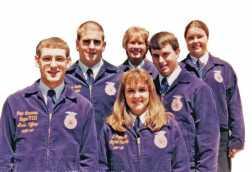

The FFA mission is to “make a positive difference in the lives of students by developing their potential for premier leadership, personal growth and career success through agricultural education.”
While that’s a lofty undertaking, FFA goes far beyond that. The organization not only aims to provide students with the tools to succeed in their educational and career paths, but for so many of its members it’s the lasting memories and friendships which have made their time in FFA such a well-rounded experience.
When memories and experiences remain with

someone for 25 years, the stories are worth noting. Every year, The Land tracks down the Minnesota state FFA officers from 25 years ago to hear of the impact FFA had made in their lives. And every year the stories carry a common thread of hard work, nerves, comradery and rewards sometimes not realized until years later.
We would like to thank the people who shared their time and stories for this issue. The Land would also like to thank the many ag instructors and FFA advisors who guide and influence our future leaders.
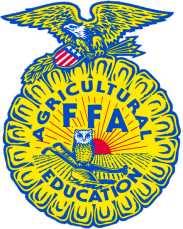 By LAURA COLE
The Land Staff Writer
By LAURA COLE
The Land Staff Writer
Leah (Schliep) Addington first got involved in FFA when her dad recommended she try an ag class her freshman year. She was just one of three girls in the class.
The first activity was to learn the FFA creed, which is five paragraphs long. Students could receive extra credit if they recited the creed in front of the class, and Addington took on the challenge. She was selected Creed speaker for her Zumbrota-Mazeppa chapter. “We participated in a national invitational Creed speaking event which allowed me to attend the national FFA convention,” Addington said. She stated she still remembers the “stars in your eyes” feeling as a ninth grader at her first convention.
Addington served as her chapter’s secretary, vice president, and president, and also served as her region’s secretary and president. When running for

state office, she recalled feeling that “any role would be well-taken.”
Named president, Addington enjoyed the sense of adventure involved in traveling the state to different events such as chapter banquets, the State Greenhand Leadership Conference, and B, I, and E tours (Business, Industry and Education). Of the tours, Addington said, “It was a highlight to be visiting schools in a part of the state that was different than where I grew up. We saw sugar beets, wheat fields, and edible bean fields. I had not previously seen this type of crop production.”
She states the officers in 1997-98 had a variety of personalities, noting Natasha “brought the fun,” Jill was “very warm and welcoming,” and John, Noah, and Pete were all very intelligent, driven, and brought a level of professionalism to the table.

Addington recognized her ag teacher, Mr. Yusten, as someone she aspired to be. She appreciated that he presented opportunities which took students out of
their comfort zone, but encouraged them to know they were capable.
After high school, Addington attended the University of Wisconsin–River Falls. In college she was involved in Dairy Club, Agriculture Education Society, internships, and was also a tour guide — noting she “was always looking for ways to grow as a person.” After receiving her degree in ag education, she went on to receive her master’s degree in ag education from the University of Minnesota–Twin Cities.
Addington has held a variety of positions within the ag industry: teaching as an ag teacher and FFA advisor for four years, serving as the FFA Leadership Development Coordinator for eight years, and working for Pioneer Seed for nine years. Since this past July, she has been employed as a sales rep for Elanco Animal Health.
Addington lives in Cannon Falls, Minn. with her husband, Matt, and three children: Cameron (15), Emerson (14), and Keaton (11). Both Cameron and Emerson are involved with the Randolph FFA chapter, where Addington previously served as an assistant advisor. “It’s a family thing for us,” Addington said.




“It’s always a good idea to keep an open mind,” John Roberts said as he recalled both his own ag journey and shared advice for the next generation of students. Roberts grew up raising pigs in west central Minnesota, though stated he did not have plans to make it his own future career. “Every ninth grader was required to take an ag class,” Roberts said, which led him to join FFA. He was an officer with the Battle Lake, Minn. chapter for three years, and served as regional vice president his junior year of high school and regional president his senior year. He held the state officer role of vice president his freshman year of college.
Coming from Otter Tail County, Roberts’ home chapter was the farthest distance away from any of the other members’ chapters. However, he was already acquainted with three of the other officers.
“Three of us had served as region presidents together,” Roberts said, referring to Leah Addington and Natasha Mortenson. He also had met Pete Lammers at Greenhand Camp.
Originally planning to focus on electrical engineering, Roberts attended North Dakota State University for one semester before transferring to the University of Minnesota campuses of Crookston, and later the Twin Cities, to major in ag education.
After graduating, Roberts taught for four years in the Glencoe-Silver Lake school district before accepting a position with Holdingford High School where he continues to teach ag classes and serves as the FFA advisor.

Reflecting on his time as state officer, Roberts shared he was given the opportunity to do and see things he might not have otherwise coming from a school with an average class size of 35 students. Roberts was able to travel to Washington D.C. for a week to attend the State Presidents’ Conference with Addington and was also a delegate at the Kansas City national convention. Another highlight was “zigging and zagging” through the northeastern region of the state for the business tour, traveling in the middle of the Iron Range and even learning about the existence of Cherry, Minn. — an unincorporated community in St. Louis County.
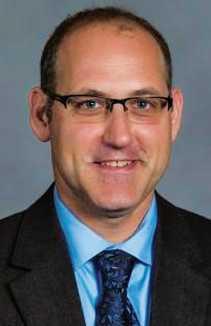 By LAURA COLE
The Land Staff Writer
By LAURA COLE
The Land Staff Writer

Growing up on a farrow-to-finish pig operation — along with a family history of FFA membership — naturally led Pete Lammers to begin his own FFA journey at Southland High School. Lammers held multiple leadership roles including chapter president. His FFA chapter was advised by Leroy Swanson. Lammers was also assistant regional officer for Region VIII the year Leah (Schliep) Addington served as president for the same region.
Of the state officer interview process, Lammers stated it was taken seriously and was kind of intense as he knew a lot of people who were running. Besides
already knowing Addington, Lammers had also previously met John Roberts at Greenhand Camp their freshman year of high school, and saw each other at conferences. Seeing so many people he had previously met made the event similar to a “class reunion, in a sense.”
Lammers was appointed secretary and served in the state officer role during his freshman year at the University of Wisconsin–River Falls, along with Addington and Jill (Guggisberg) Grams. “I have really good memories of the time,” Lammers shared. He noted there was “a lot of carpooling to Minnesota.”
Lammers said their team worked well together, recalling job duties such as putting together Greenhand and
Leadership camps, and attending the state convention. “There’s a lot of work that goes on behind the scenes,” Lammers said.
He also mentioned the big impact Jim Ertl had on not only him, but also many other students during Ertl’s time with the Minnesota FFA Association. With a variety of interests, Lammers found himself switching career paths a few times throughout college. He settled on a degree in broad area agriculture — a “choose your own adventure major,” Lammers remarked. An advisor encouraged him to attend graduate school, but Lammers opted to join the work force, working for a year or two with the U.S. Department of Agriculture as a soil conservation technician. When he did attend grad school at Iowa State, he credits mentor Dr. Mark Honeyman as someone who “really got me thinking about teaching on a collegiate level.”
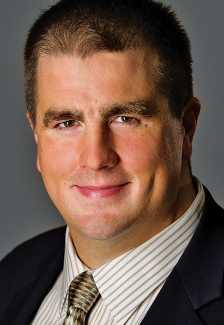 By LAURA
By LAURA
served as state officer for both organizations. While some aspects of FFA were familiar territory due to his upbringing on a livestock farm, Barka mentioned one of his favorite things was learning about topics he had not initially considered to be part of the FFA realm — such as forest resources and mining. “It opened up my perspective on what agriculture is,” he said.
Looking back, Barka appreciates that the value of teamwork is introduced in FFA. He mentioned many instances of gaining beneficial experience from working on teams, such as in judging, sales, and various statewide events. “There is a real skill to that,” he said, adding that the project
work in FFA gives students real life experiences of working on teams and proved to be helpful later on.
Barka held leadership roles within his Litchfield, Minn. chapter and recognized his two ag teachers for the different strengths they brought to the chapter. “Jere Rambow and Bob Rick were both very inspiring teachers. Mr. Rambow in encouraging you to try things like judging or speaking contests, and be aspirational in leadership roles and SAE projects — much more than I would have otherwise. Mr. Rick really excelled in getting teams to work well together and how to think
 By LAURA COLE
The Land Staff Writer
By LAURA COLE
The Land Staff Writer
In the early 90s, a young Natasha (Cronen) Mortenson was growing up on a Minnesota crop farm and “definitely did not think farming was cool.” But her attitude changed during her ninth grade year, and she has her ag class to thank for that. Mortenson shared her advisor of the Benson, Minn. Chapter was Chuck Erickson and noted he had a special skill of knowing how to work with each student.
As a freshman, she placed first in ag sales at the regional level, and remembers being “pretty
sold” at that point.
Mortenson held various roles in her local chapter and during her senior year of high school served as regional president. She held the state reporter role her freshman year of college at the University of Minnesota–Twin Cities where she earned a degree in ag education.

“We had to work hard,” Mortenson recalled of her state officer commitment, noting the group didn’t have the luxury of Zoom at that time. Mortenson stated that between her and the other five officers, there were a lot of different

skills and personalities — adding that with a diverse group they are able to reach out to as many different students as possible. “We learned a lot from each other,” she said.
Top FFA memories for Mortenson include attending her first national convention in Kansas City. “It was the moment my life changed.” Remembering the huge convention center, she added, “I’ll never forget the feeling.”
Mortenson also cherished the leadership positions she was able to hold and working with different types of people. She noted what set FFA apart from other organizations is that while adults were providing support, “it really was student-driven, student-led.” Mortenson reflected that failures help make better humans and made her a better adult. “Where would I be with-
out the lessons learned?”
Allowing students to grow through failure is a concept that Mortenson carried over when she became an ag teacher, acknowledging how hard that can be. She taught for 14 years in Morris, Minn. For the past eight years she has been working in community relations with Riverview — a dairy company headquartered in Morris. Mortenson is also one-third of the team behind the podcast, “Keepin’ It Rural.” She runs the show alongside butcher Lindsey Loken and ag teacher Rebekka Paskewitz. The trio’s goal is to use their platform to share agricultural truths directly from the sources. Their first episode aired September 2022 Dr. Temple Grandin as their guest.
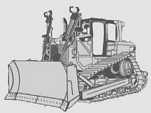
As a freshman in high school, Jill (Guggisberg) Grams never saw her life taking the direction it did. “I didn’t think I wanted to be a part of agriculture,” she recalled. That changed when her high school at Gibbon-Fairfax-Winthrop made a course restructure and she found herself enrolled in an ag class.
She admits being less than thrilled. Her ag teacher, Mr. Hermanson, then suggested she sign up for FFA — with her dad agreeing it was a good idea. Not exactly interested, Grams did see one silver lining: she had always wanted to attend a camp. The State Greenhand Leadership Conference is an overnight experience that serves as an introduction to FFA. So she signed up, went to Greenhand, and as Grams puts it, “The rest is history.”
“I served as chapter sentinel, chapter president, and was Region VII sentinel,” Grams said. She remembers a rigorous interview process for the state officer position, completing group tasks, writing exercises, and individual interviews before being appointed sentinel.
Grams served as sentinel as a sophomore at the University of WisconsinRiver Falls where she majored in ag education — a decision also encouraged by Mr. Hermanson. Grams had initially planned on majoring in ag business,
but eventually agreed ag education was the right fit. Grams said of her former teacher, “He was right about the fact that I should go into FFA. He was right about the fact that I should go into ag education.”
Grams was the 4-H program coordinator in McLeod County for 13 years. She has now been teaching ag education for grades 7-12 in the Buffalo Lake-HectorStewart school district for seven years. She also serves as the school’s FFA advisor. Every so often, Grams brings in her state officer jacket upon a student’s request. She shared the characteristics held by Mr. Hermanson which she hopes to emulate in her role: being kind, encouraging, and someone who teaches students to believe in themselves.
Grams lives on an acreage south of Buffalo Lake with her husband, Kyle, and is the proud mom of two boys: Ethan, who is employed as a welder and Mason, currently a senior in high school. She’s had the special privilege of advising both of her sons in their own FFA journeys.
Recalling her own FFA experience, Grams treasures the friendships made along the way, especially the close bond her GFW Pioneer Express chapter formed with the WatertownMayer chapter after they rode the same bus to national convention. The chapters invited each other to activities like hay rides and sledding. As a state officer, Grams noted the teamwork involved to plan events. Some of the officers also attended UWRF with Grams. “We did a lot of traveling together back and forth to events. We got along really well. We supported each other.” Grams
sees others occasionally at fairs and conventions. “It’s fun to reconnect.”
While Grams knows firsthand the commitment required to be a state officer, she recognizes the value in the role.
“Their face is so important to agriculture and the ag industry.” Grams stated she utilizes FFA officers on a local level.
“To have them back us is amazing.”
Looking back, Grams stated, “I never anticipated where FFA was going to take me.” Now, she sees FFA as an opportunity for youth to find themselves.
Her advice to current members? “Do it all,” Grams encourages. “Take the opportunity to travel whether it’s camp or a regional event. Do things in your community.” She credits FFA with teaching her how to believe in herself and challenge herself, and has also given her lasting friendships. “Soak up everything you can.” v
Since 2020, the agricultural education classes at Faribault High School, in this town of 25,000, have grown more than four times — from 90 students in 2020 to 415 students in 2022.

Madeline Schultz, a 2014 graduate of Faribault High School, came on board as the schools
Agricultural Education instructor in 2020 with a vision. She intended to show students all aspects of agriculture — from production to processing to marketing to eating — by using a creative curriculum with a strong handson component. She believed once students understood how a chicken was raised and how it arrived on the grocery store shelves, they would become not only advocates for agriculture but they would understand the wide range of career opportunities associated with agriculture.
To that end, Schultz — backed by a $5,000 grant from the U.S. Department of Agriculture and a Minnesota FFA partnership, restarted the school’s agricultural education program by launching a series of innovative courses.

“The opportunity to bring agricultural education back to the high school was super exciting,” Schultz told the Faribault Daily News when she was hired.
“It wasn’t here when I was in high school, so I’m passionate about getting involved in bringing it back.”
The courses she introduced included “Raising Chickens,” “Companion Animals,” “Plant Science,” “Meat Science,” and “Exploring Agriculture.”
In the “Raising Chickens” class, students learn about the basics of poultry production. That includes, Schultz said, the importance of bio-security during the avian flu outbreak. But the agricultural classes at Faribault High go beyond theory.
“We have a broiler flock and a layer flock,” Schultz said.
The students are involved in managing all aspects of the two flocks — from receiving the day-old chicks in the mail to putting them into brooders to feeding them … and, in the case of the broilers, harvesting them.
“We harvest and eviscerate them outside,” says
Schultz who raised chickens as a youngster, “but we finish processing them in the processing facility the school has built.”
The processing facility, with freezers, coolers, floor drains, and stainless steel tables and sinks, is in a converted office space which is in what Schultz describes as a very large classroom.
“When the students are done they take a chicken home,” Schultz said. “It’s super important that kids understand what’s involved in raising a chicken and why producers do what they do.”
The agricultural classes also use the processing facility to make processed meat products such as beef
jerky and pork sausage. It’s important that students understand the importance of processing and adding value to meat products, according to Schultz.
The “Exploring Agriculture” class includes more traditional agricultural education material such as learning about the wide range of livestock breeds. A high point for students is to see some of the breeds they’ve been studying in real life, Schultz says. “Exploring Agriculture” students also get to make ice cream.
“They study different types of ice cream and then they learn how to develop an ice cream business plan,” Schultz, who wants her student to visit a robotic dairy, said. “Once they have a plan, they run it by their classmates to get their input.”
Faribault’s “Plant Science” class features hands-on experience growing greenhouse lettuce in hydroponic and aeroponic production systems.
Schultz also teaches a companion animal class. “We call that class Exploring Animals,” Schultz said. “In it, students learn about how to take care of small animals such as dogs and cats. We also have guest speakers come in — such as a vet and an owner of a dog resort — to talk about possible careers with small animals.”
As the Faribault agricultural education program grew in recent years, it took on a second teacher. Among her six classes are metals and welding, taxidermy, fish and wildlife, and field biology.
Schultz says enrollment in agricultural education has probably grown because students in the early grades are now able to choose to take more elective classes than they were in years past. There are other reasons as well, she says.
“A lot of kids want hands-on learning. They learn best that way,” Schultz said. “As kids have realized that’s what we do, they promote our classes through word of mouth. At the same time, I try to support what kids are learning in math and English and more traditional academic courses.”
In addition to teaching her classes, Schultz is the school’s FFA advisor. All of her agricultural education students are eligible to join FFA and many do. v
Since 1986, Minnesota Agriculture in the Classroom, a Minnesota Department of Agriculture division, has been publishing a magazine series to enhance classroom curriculum for children ages kindergarten through sixth grade called the AgMag. During the 2023 school year, nearly every school district across the state will have the AgMag as an enrichment tool in the classroom. “It’s our flagship publication! That’s really the first thing that Minnesota Ag in the Classroom did when it got started back in the 80s,” said MAITC Education Specialist Keri Sidle.

“What’s really great about the AgMag is it’s a way for teachers to enhance their curriculum. It’s standardsbased, but it’s a non-fiction resource about Minnesota agriculture,” explained Sidel. “We try to do this in a really appealing-to-kids way.”
kids would get [every issue] from kin dergarten to sixth grade and really get a full picture of agriculture in Minnesota,” she said.
One of the benefits of the AgMag is that it is standardsbased. “We choose the content for AgMag based on the Minnesota Academic Standards. So depend ing on what topics are covered in each grade level is really what guides what topics we choose; but we make them agriculturally themed,” Sidle shared.
MAITC has former school teachers on staff, including Sidle, and a team of teachers who review each issue before printing.
for 5th through 12th grade called “Farm Camp.” Farm Camp is a new program in its pilot year. Attending the camp is free of charge and transportation grants are available to help cover costs. Sidle said, “This program looks to connect 5th through 12thgrade classrooms to a farm or ag business to take a field trip and do an immersive experience before and after the field trip around ag careers.”
Keri SidleAgMag is not a onesize-fits-all tool; MAITC publishes two issues each year for each grade level, K-6 for a total of 14 issues per year. Not only do they publish 14 issues, but each issue is unique. “Minnesota agriculture is a wide-ranging industry from small farms to big farms, livestock to corn and produce. Our goal is that
Seventy thousand issues of AgMag were sent out this school year, said Sidle. And the best part about AgMag is that it is free of charge! Furthermore, MAITC also provides teachers with extra curriculum to extend ag-based learning. “I do think teachers tend to gravitate toward the print because it’s not that often as a teacher that you can find local, statebased content for Minnesota that’s in print and in color, free of charge,” said Sidle. “Our model is teachers go to our website and sign up to receive the AgMag. We like the model in that teachers, individual-
SLAYTON, Minn. — Murray and Pipestone county cattlemen associations are hosting the annual Minnesota State Cattlemen’s Association Summer Beef Tour and Trade Show on July 17 and 18.
The tour will showcase experienced cattlemen, innovative techniques, quality beef setups and vendors featuring new products and services.
The Summer Tour events begin with the quarterly board meeting of the MSCA at Key Largo on Lake Shetek, just north of Slayton.
The tour and trade show will take
place on July 18. This year’s tour begins in Pipestone, Minn. and will feature farm stops in Murray and Pipestone counties.
To register for the tour, visit eventbrite.com/e/murraypipestone-countysummer-tour-2023-tickets-578342978417 or visit MSCA’s website at mnsca.org.

For more information, contact Angie Ford at (507) 360-7937 or Glenn Johnson at (507) 820-1502.
This article was submitted by the Minnesota State Cattlemen’s Association. v
ly, sign up and decide to use it rather than it being required.”
Sidle said one of their biggest challenges is getting the word out that AgMag is available. “There are so many resources out there that teachers can use, and there is so much that they need to teach,” she said. The MAITC attends various conferences for teachers and uses online platforms and word of mouth to share its resources.
AgMag can also be found online, so students, parents and teachers can access it at any time. They also have a YouTube channel where they take students on virtual field trips and feature “Harvest of the Month” and “Follow Your Food” videos.
MAITC does more than just publish materials for K-6 learners. They also have a curriculum, hands-on learning opportunities, and career exploration
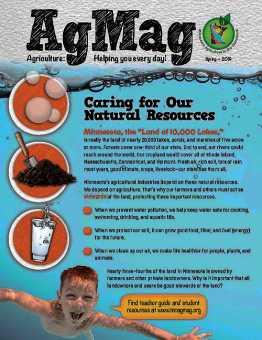
Coming from a non-agricultural background, Sidle is passionate about getting ag-related resources into the classrooms. While she was a student at the University of Florida, Sidle became an ambassador for the college of ag and life sciences while pursuing a nutrition degree. However, her career path changed once she attended the national FFA convention. “I had never really heard of FFA before I went to [the convention]. I was fascinated by what all of these [agricultural industries] were doing to provide our food supply and beyond. I loved it! I went to the national FFA convention to recruit students for the University of Florida. While I was there, I decided to change my major to become a high school teacher and FFA advisor [so I could] show kids all of these different careers in agriculture and the whole world of agriculture, and I’ve loved it ever since!” she shared. There is a growing interest in connecting agriculture to everyday life and that is precisely the goal of MAITC. For more information and free resources, check out https://minnesota.agclassroom.org. v
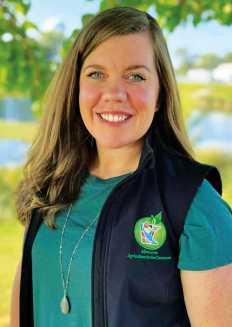
SCHLIEP, from pg. 11
The FFA mission statement of developing student potential for “premier leadership, personal growth and career success” is something Addington believes in, stating, “I experienced it myself.” She shared how incredible the opportunities are for networking, being able to meet industry leaders, and developing contacts for internships and references. “In my opinion, it’s one of the greatest organizations that a student can be a part of,” Addington said.
BARKA, from pg. 11
more broadly about what we could do and accomplish as a local FFA chapter,” Barka remarked.

Barka held the state officer role of treasurer during the same year he began his undergraduate degree at the University of Minnesota–Twin Cities. He recalled the 1997-98 team being congenial and having a lot of fun during his time in the role. Barka added the group’s different perspectives were beneficial in completing their required duties, such as setting up events.
The opportunity to travel to other areas of the state was a highlight for Barka. He particularly valued visiting northern regions of Minnesota during the Business, Industry, and Education tours. Barka also stated he enjoyed being able to share his perspectives through the public speaking events, as well as meeting other members in different chapters around the state.
Becoming a dairy vet was Barka’s “whole plan from the jump.” He was accepted into the veterinary medicine program at the University of Minnesota. Noting it’s a competitive program, Barka gives credit to the youth organizations he was involved in that assisted him in developing a variety of skills.
“It’s where I met some of my greatest friends.”
Her advice for anyone considering FFA is simple: “Go for it.” She noted the many avenues students can take, the experiences to gain, and the connections to be made. And FFA continues to impact Addington’s life.
“Your FFA experience does not stop when you take off your FFA jacket.” v
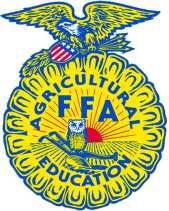
During vet school, Barka switched gears when he learned about the option to develop medical devices for people. He has been with Medtronic since 2004 and is a Technical and Bakken Fellow in the organization. In his current role as a distinguished scientist, Barka shared that he is constantly applying skills he learned when he was in FFA. Physicians present the obstacles they’re facing and he problem-solves solutions.

Barka credited FFA with teaching him about “opening assumptions” and seeing things in different ways, not just from his initial perspective. He also added that the lessons taught to him by his ag teachers “have been broadly applicable in my career choices and team building approaches in organizations today.”
Now living in Ramsey, Minn., Barka enjoys woodworking and gardening in his free time. His advice to current FFA members is to “keep an open mind.” He encourages them to stay curious about the different pathways available as he found in his own experience the new options that arise can be “extremely rewarding.” v
CRONEN, from pg. 13
ROBERTS, from pg. 12
Robert’s stated how his high school advisor, Blaine Larson, effectively “knew how to push people,” and how helpful the previous ag teachers at Holdingford were to him. “They were almost like a second and third ag teacher for me,” he said. Arlynn Lawrence retired upon Roberts’ arrival, but continues to serve as his substitute. Mark Stai worked alongside Roberts until he retired, and both taught him new things. Roberts said a hallmark of the Holdingford chapter is students are involved in a tractor restoration every year. Once it’s reached “parade queen” status, the tractor is raffled off.
“Being on the other side of the table, as a student you don’t recognize the amount of time that goes in as a teach-
LAMMERS, from pg. 12
Lammers also stated he’s not sure he would have attended grad school had it not been for the experiences he gained during his time in FFA — noting the program assisted him in building confidence and self-awareness.
Majoring in animal science and sustainable agriculture, Lammers received his Ph.D. and taught several years at Illinois State University. He has been with the University of Wisconsin–Platteville for the past seven years teaching a variety of undergraduate courses within the college’s School of Agriculture. A highlight Lammers shared is being able to teach students multiple times throughout their undergrad journey.
A benefit to UW-Platteville’s location is being an equal distance from Lammers’ family in Minnesota and his wife’s family along with some of his family in the Chicago area. Lammers
Agriculture is huge for Mortenson’s family as well. She lives in rural Danvers, Minn. with her husband, Matt, who is a farmer. They have two children: Grace and Cowan. Grace will soon be following her mom’s footsteps and majoring in ag education. Cowan is currently a junior at Morris High School. Both offspring have a cattle herd.
25 years ago, Mortenson said she did not anticipate the kind of network she’d be able to create as a young person and the reconnections she continues to make throughout her life. She stated she’s had many opportunities which have come through relation-
er,” Roberts said. He relayed a previous student’s comment that FFA is an organization which gives and gives. Members can take as much as they want, and still FFA continues to give. Roberts is in agreement with the sentiment. He commented FFA has so many opportunities “if a student is willing to put in the time.” He finds it especially rewarding to see his students go on to become productive citizens and be successful in their own operations.
When he’s not in the school’s shop, Roberts enjoys fishing and hunting. The jury’s still out on how good of a hunting dog his two-year-old Beagle Labrador cross will be, but shared Chester is showing a lot of promise. Roberts also collects antique Farmall tractors and grows sweet corn in the summer. v
and his wife, Jen Filipiak, live in rural Belmont, Wis. on an acreage. Filipiak is the Executive Director of the Driftless Area Land Conservancy.
Lammers recalled asking himself “now what?” after having been so involved in FFA and having the experience end. He insightfully remarked that although what you’re doing currently won’t always be the most important thing, “it will set you up for the next most important thing.”
Whatever paths the next generation of FFA students find themselves taking, Lammers gives the kind of advice apt for a professor (with a laugh): “Go to class.” He also encourages them to do what they enjoy — emphasizing it might not always be easy or come without struggle. He concluded, “Life is too short and too long to not enjoy what you’re doing.” v
ships she’s formed in FFA. For example, Mortenson and Loken first met as FFA members, reconnected years later through the Minnesota Beef Council, and now work on their podcast together.
Mortenson shared how the ag teachers she most admired put opportunities in front of their students and it was up to each person to take them. She discussed how fear can get in the way of people trying new things; but her words of wisdom to current FFA students is to do it anyway. “Do all the things and do it scared.” v
In classrooms throughout the United States (and even outside the country), the usual class pets of goldfish and gerbils are moving aside for Holstein and Jersey cows. Discover Dairy established the Adopt a Cow program in 2011 and their outreach continues to grow.
The program was developed thanks to a staff member’s son’s second grade class. Emily Barge, the communications and marketing manager with the Center for Dairy Excellence Foundation, shared that this particular classroom adopted a jaguar from Africa. The staff member thought if a classroom can adopt a jaguar, why not a cow? Discover Dairy saw this idea as a great option to expand their work, and the program began.
The Dairy Excellence Foundation manages Discover Dairy, an educational series which provides lessons designed for grades 3-5 and 6-8. The lessons include activities, worksheets, reading materials and videos, and are available to anyone interested in providing dairy education. According to its website, Discover Dairy meets Common CORE standards for math, science and reading.
The Adopt a Cow program runs adjacent to a traditional school year. The initial host farm and calf announcement is sent in October with information and updates provided close to monthly. Barge stated on off-months, the program provides corresponding materials such as a farm tour video. Twice a month, groups receive extra lessons and activities. Towards the end of the school year, participants are able to be part of a live chat with the host farm and calf.
Discover Dairy is based in Pennsylvania, but makes its impact globally. Barge reported that 40,500 classrooms are enrolled in the free Adopt a Cow program for the 2022-23 school year which impacts 1.2 million students. Classrooms are represented in all 50 states as well as in 55 countries. The 33 contributing farms are spread throughout

the United States and Barge stated they make an attempt to match participants with a cow near their area.
“There are 60 classrooms in Minnesota enrolled in the Adopt a Cow program,” Barge stated. Minnesota also is home to one of the participating farms in the program.
Tauer Dairy, located in Brown County, Minn., has been involved in the program twice over the past several years. A 2022 Farm Family of the Year, the Tauers have about 275 Holsteins and also farm about 500 acres — mainly alfalfa and corn.


Not usually apt to name their calves, “Peaches” was their first calf involved in the Adopt a Cow program in 2017-18, and “Pearl” was their most recent in 2020-21. Angie Tauer shared the Discover Dairy organization has been great to work with.
Tauer, also a middle school science teacher at St. Mary’s in Sleepy Eye, Minn., said a favorite part of her involvement was connecting with the students. “Not every kid gets to see a farm.” She stated it was fun to put videos together of the farm and answer the students’ questions. “The best way to teach people is just be real,” she shared.
With a passion for ag promotion, Tauer also loves making connections with other cultures.
Since 2010, the family has housed interns through the University of Minnesota’s MAST program.
(MAST brings young people from around the world to train for 3-18 months in greenhouses, farms, research labs, and wineries, where they learn new skills, improve their English, and experience American life.) Tauer said she enjoys that her and her husband’s two children have been able to grow up with this unique experience.
While the majority of the classrooms Tauer Dairy was paired with in 2020-21 were from the central Minnesota area, the farm was previously connected with classrooms in Oregon and Washington, as well as an innercity school in San Diego, Calif.



“The program has grown exponentially,” Barge said, especially noting the increased interest due to the Covid pandemic. She shared teachers were looking for virtual options to engage students, and homeschooling parents were looking for activities for their children.
Barge also stated a lot of nursing home and assisted living facilities signed up for the program during that time as well.
Since 2020, the program has continued to steadily grow. For Valentine’s Day, Discover Dairy held a “Most Kissable Calf” poll. Over 1.5 million votes later, the crowned winner out of the 84 calves was a Holstein named Willow.
Barge has been with the Dairy Excellence Foundation for about four years. She admitted the most meaningful aspect of the program has been the impact it’s making on the classrooms. “I’ve always
The following marketing analysis is for the week ending March 24.

CORN — Corn consolidated higher this week, but it tried to break out both to the upside and downside on various days. The May corn contract settled between $6.30 and $6.33.5 per bushel March 20-23 as it traded to a new high for the month and before it concluded the week with a nice upswing. December angled lower through the week to trade to its lowest since late July and closed every day this week before March 24’s rally to cut losses.
A big factor over the last couple of weeks has been the exit of managed money length. It’s estimated they are short 42,200 contracts as of the close on March 23. However, we have reached prices to attract export business and improved ethanol margins.
The U.S. Department of Agriculture announced corn export sales to China for four straight days totaling 26.2 million bushels.
The Black Sea grain corridor has been extended for 60 days, so that gives us some breathing room. Russia wants relief on sanctions that make it difficult for customers to buy their commodities and will likely push that argument when the deal comes due May 18. With the extension of the Black Sea grain agreement for only 60 days, vessel insurers are requiring a short renewal frame of every seven days in case the situation changes.
We continued to see more corn export sales announcements to China this week. Weekly export sales were at a marketing year high at 121.9 million bushels thanks to the persistent Chinese interest last week. Next week’s sales will also include some of the sales and we should see another high number.
Total export commitments at 1.375 billion bushels are down 34 percent from last year vs. down 39 percent last week. The USDA is predicting a 25 percent year-on-year decline in exports. We need to average 17.2 million bushels of sales per week to ring the bell on the USDA’s 1.85-billion bushel export forecast.
Weekly ethanol numbers were neutral to slightly bearish. Ethanol production was down 17,000 barrels per day to 997,000 bpd and was the lowest in 10 weeks. Ethanol stocks fell 206,000 barrels to 26.2 million barrels. This was a record high on a sameweek basis. Net ethanol margins improved by 2 cents
cents higher at $6.43, July gained 5.25 cents at $6.23, and the December contract only saw a penny decline to $5.60.25 per bushel.
SOYBEANS — “Ouch!” comes to mind when you look at the soybean chart. From the March 6 high in May soybeans at $15.38.5 to this week’s $14.05 low, this contract plunged $1.33.5 per bushel before bouncing. For the same time frame, the November soybean contract crumbled from a high of $13.86.5 to a low of $12.47.5 for a $1.39 per bushel decline. November soybeans closed lower for 13 consecutive sessions as of March 23’s close before snapping the streak to end the week. This was the longest losing streak for a new crop soybean contract within its expiration year since 1973! Basis numbers have firmed in many areas, but not anywhere near enough to make up for the extremely heavy fund selling.
to 30 cents per gallon. Gasoline demand was at a three-week high at 8.96 million bpd.
The Federal Reserve met trader expectations this week by raising interest rates 25 basis points to a range of 4.75 to 5 percent. This is the highest rate since September 2007. Their comments suggest we’ll see another small increase in May, but they did drop the phrase “ongoing increases” from their comments.
The Buenos Airres Grain Exchange in Argentina kept their corn production estimate unchanged at 36 million metric tons vs. the USDA at 40 mmt. Recent rains may stabilize the corn crop.
A news report on March 24 said that Russia was considering temporarily halting or limiting wheat and sunflower exports. The announcement gave a substantial boost to wheat prices which spilled over to the corn market. However, by mid-morning, Russia disclaimed the report. It was also reported Russia was considering increasing grain purchases from the 2023 grain crop for grain reserves to 10 mmt from this year’s 3 mmt to support domestic prices.
China’s President Xi met with Russian President Putin recently and will meet with Brazil’s President Lula this coming weekend. China is strengthening ties with its trading partners.
Outlook: Traders are anxiously awaiting the March 31 Prospective Planting and Grain Stocks reports. The widening old crop inverses suggest the stocks number may be tight. The falling ratio of soybeans to corn may push some uncommitted acres to corn at these levels. The CZ/SX ratio was 2.27 at the end of the week. May corn on March 24 closed at its highest settlement for the month and December corn posted a key reversal higher.
For the week, May corn managed to bounce 8.75
Crush margins have been declining for the last two weeks to the lowest since July in the May crush and since December in the July crush. As of March 23, it was estimated that managed money was still long 80,700 soybean contracts. Basis levels and prices have fallen sharply in Brazil as their harvest picks up and is nearing 75 percent complete.
Weekly export sales were disappointing at 5.6 million bushels and below the lowest trade estimate. This was the second-lowest weekly total of the marketing year. Total export commitments at 1.818 billion bushels are down 8 percent from last year compared to the USDA’s projection of a 6.6 percent decrease in exports year-on-year. We need to average 7.8 million bushels of sales per week to attain the USDA export forecast for 2.015 billion bushels.
Weekly meal sales were the lowest in four weeks while soyoil sales were a marketing year high. Soyoil hit an eight-month low this week and meal a sixweek low on fund liquidation.
Abiove estimated Brazil’s soybean production at a record 153.6 mmt with exports at a record 92.3 mmt. Agroconsult has the crop at 155 mmt and exports at 96 mmt. The USDA has Brazil’s crop at 153 mmt with exports at 96.5 mmt. The BAGE kept its Argentine soybean estimate at 25 mmt compared to the USDA’s latest estimate of 33 mmt. The USDA attaché to China estimates their soybean imports at 97.5 mmt vs. USDA at 96 mmt. There are rising concerns about increasing cases of African Swine Fever in China’s hog population and what that will mean for feed demand.
Outlook: Long funds were rushing to the exit this week and there hasn’t been any indication they are finished. The upcoming March 31 reports may put some hesitation in the action ahead of the reports. With current world conditions, we can’t afford any weather glitches in the United States this year. I believe we said the same thing last year.
The soybean/corn ratio favors planting any uncommitted acres to corn. May soybeans traded to their
This column was written for the marketing week ending March 24.

Dairy farm milk tanks are not being refilled very quickly. The U.S. Department of Agriculture’s latest preliminary data shows February output at 17.68 billion pounds. This is down 1.6 billion pounds from January, but 135 million or 0.8 percent more than February 2022, and less than the 1.3 percent increase seen in January.
The 24-state total, at 16.9 billion pounds, was up 1 percent from a year ago. Both January totals were revised up 5 million pounds.
since July 2021.
Output per cow averaged 1,877 pounds, up 7 pounds or 0.4 percent from 2022.
February was the eighth month in a row that milk production topped that of a year ago.
Farms are adding cows. Cow numbers totaled 9.42 million, up 12,000 head from the January count which had no revision, and was up 37,000 head from a year ago, largest dairy herd since August 2021. The 24-state count was up 12,000 from January and 54,000 above a year ago, the largest
California cows put 3.3 billion pounds of milk in the tank in February, down 29 million pounds, or 1 percent from a year ago (due to lots of rain), 2,000 fewer cows, and a loss of 20 pounds per cow. Output there hasn’t really shown much of an increase since August 2021. Wisconsin output, at 2.4 billion pounds, was up 7 million or 0.3 percent, due to a 10-pound gain per cow offsetting a loss of 3,000 cows.
Texas was up 5.5 percent thanks to 22,000 more cows and a 40-pound gain per cow. Idaho was up 3.4 percent on 15,000 more cows and a 20-pound gain per cow.
Florida again registered the biggest loss, down 11.4 percent. Michigan was up 3.1 percent, thanks to a 30-pound gain per cow and 7,000 more cows. Minnesota was up 1 percent on a 10-pound gain per
lowest since October but managed to stay above the $14.00 per bushel level. November soybeans traded to their lowest since July as they faded below $13.00 per bushel.
May soybeans failed at $15.00 per bushel and didn’t look back until fund selling evaporated into the weekend. November soybeans have slipped below $14.00 per bushel and was able to cut the weekly loss
into the weekend. For the week, May soybeans tumbled 48.25 cents to $14.28.25, July crashed 55 cents to $14.06.25, and November plunged 40.25 cents to $12.73.25 per bushel.
Weekly price changes in May wheat for the week ended March 24: Chicago wheat dropped 22 cents to $6.88.5, Kansas City was 12.25 cents higher at $8.48, and Minneapolis fell 3.25 cents to $8.57.5 per bushel.
ADOPT A COW, from pg. 17
loved education.” Through the Adopt a Cow program, Barge said students are able to learn about an industry they may have never been exposed to before as many students come from urban areas. Barge explained farmers often have an idea what stores their cows’ milk is going to and what brand will be supplying it. That knowledge helps a student make a closer ag connection the next time they go to a grocery store.
Barge also enjoys seeing the creative things teachers come up with to incorporate into the lessons. An example Barge gave is the implementation of a growth chart. It provides the visual of cows being different sizes. There’s a universal message to be learned that everyone is different and an individual.
This year, the Adopt a Cow program is a part of 200 Spanish-speaking classrooms. Barge stated those classrooms are paired with a farm with a Spanishspeaking contact, so they are able to connect during
the spring live chat.
For many of the elderly populations residing in facilities, agriculture was a big part of their upbringing. Barge shared that many residents involved in the program had memories of growing up on a farm or an ag connection. The program resurfaced past times, even for some dealing with memory loss.
Barge notes Adopt a Cow would not be possible without the partnership of 13 dairy organizations throughout the United States. Minnesotans participating in Adopt a Cow specifically have the Midwest Dairy Association to thank for their assistance in making the program available to the area.
Teachers and facilitators of a variety of programs — including 4-H, library and after-school programs — are eligible to sign up for the 2023-24 school year. Registration begins May 1. Interested parties can visit discoverdairy.com/adopt-a-cow and submit their email address to receive more information. v
cow and 2,000 more cows. New Mexico was down 4.2 percent on 12,000 fewer cows, though output per cow was unchanged. New York was up 2.9 percent, thanks to 10,000 more cows and a 25-pound gain per cow.
Oregon was down 2.4 percent on a loss of 3,000 cows. Output per cow was unchanged. Pennsylvania was off 0.1 percent on a loss of 2,000 cows, though output per cow was up five pounds. South Dakota was up 6.2 percent, thanks to 12,000 more cows offsetting a 10-pound loss per cow. Vermont was down 1 percent on 1,000 fewer cows, though out per cow was up five pounds. Washington State was down 2.2 percent on 6,000 fewer cows. Output per cow was unchanged.
The March 20 Daily Dairy Report warned, “Greater milk output in nearly every Midwestern state overwhelmed the region and resulted in steeply discounted spot milk prices and smaller checks for dairy producers. Cooperatives in Texas frequently dumped milk, despite self-imposed caps on members’ output.”
Flooding occurred throughout California — covering fields and roadways with water, reports HighGround Dairy, “closing primary and alternative routes throughout the state, delaying transportation and causing plant downtime. The state remained under siege this week and Governor Newsom designated 40 counties as disaster counties, including Tulare, Fresno, Kings, Madero, Mariposa, and Merced.”
Meanwhile, a Nor-easter dropped three feet of snow on parts of New England last week which caused delayed milk pickups, according to Dairy Market News. However, milk production was steady in other parts of the Eastern seaboard.
The Federal Reserve raised interest rates for the ninth time in a row this week by a quarter percent to just under 5 percent in its ongoing effort to control inflation. The action comes in the face of the collapse of two regional banks.
Lots of eyes are on dairy culling as finances tighten on the farm. The USDA’s latest Livestock Slaughter report shows an estimated 266,500 head were sent to slaughter under federal inspection in February, down 31,400 head from January, and mirrored numbers in February 2022. Culling in the two month period totaled 564,400, up 37,000 or 7 percent from the same period a year ago.
The week ending Mar. 11 saw 67,300 head go to slaughter, up 421 head from the previous week and 2,300 more than a year ago. Year-to-date, 673,400 cows have been culled, up 24,000 head or 3.7 percent from the same period in 2022.
We have plenty of butter. The USDA’s latest Cold Storage report shows the Feb. 28 inventory at 295 million pounds. This is up 30.7 million pounds or 11.6 percent from the January figure which was revised 1.6 million pounds higher, and was 32 million or 12.2 percent more than February 2022. It was the third month in a row butter stocks topped those of a year ago but the report is viewed as neutral to the market.
American cheese stocks fell to 816.9 million pounds, down 6.5 million pounds or 0.8 percent from the January inventory which was revised up 4.6 million pounds. Stocks were down 14.2 million pounds or 1.7 percent from a year ago.
The “other” cheese category crept up to 605.5 million pounds, up 5.7 million pounds or 0.9 percent from January, and 5.1 million or 0.8 percent above a year ago.
The total cheese inventory came in at 1.446 billion pounds, down 234,000 pounds or 0.02 percent from January, and 20.7 million or 1.4 percent below a year ago.
Woes continue in international dairy trade. The
March 21 Global Dairy Trade’s weighted average dropped 2.6 percent following the 0.7 percent slip on March 7, and 1.5 percent on Feb. 21. Traders brought 59.1 million pounds of product to market, up from 59 million March 7, and the average metric ton price slipped to $3,361 U.S., down from $3,403.00 on March 7.
Cheddar led the declines, down 10.2 percent after dropping 10.2 percent on March 7. Anhydrous milkfat was down 3.8 percent following a 1.8 percent decline, and butter was down 3 percent after a 0.3 percent slip. Skim milk powder was down 3.5 percent following a 1.1 percent descent, and whole milk powder was down 1.5 percent after inching up 0.2 percent.
StoneX Dairy Group says the GDT 80 percent butterfat butter price equates to $2.1012 per pound U.S., down 6.7 cents, and compares to Chicago Mercantile Exchange butter which closed March 24 at $2. GDT cheddar, at $1.8381, was down 20.7 cents, after losing 26.2 cents in the previous event, and compares to March 24’s CME block cheddar at a very pricy $2.10. GDT skim milk powder averaged $1.2012 per pound, down from $1.2424, and whole milk powder averaged $1.4641 per pound, down from $1.4865. CME Grade A nonfat dry milk closed
March 24 at $1 per pound.
Analyst Dustin Winston says, “North Asian purchases — which includes China — were higher than last year and the last event as the region continues to stay above 50 percent market share since returning to this trend in February.”
China’s dairy imports indeed looked a little more favorable, according to the latest data. HighGround Dairy points out China did not release January data during the usual time in February, but waited to release January and February data at the same time in March — an occurrence which began during the pandemic.
February imports of skim milk powder totaled 108.2 million pounds, down 31.1 percent from February 2022. However, skim milk powder imports totaled 89.2 million pounds, up 42.9 percent.
Market share of skim milk powder is steadily changing, says HighGround Dairy, with New Zealand’s share falling in January to 53 percent, from 64 percent the year prior. U.S. skim milk powder market share increased the most, shifting from
ST. CLOUD, Minn. — As we enter the month of April, at the top of everyone’s mind is warmer weather and the growing season to come. Many cattle producers are chatting at the coffee shop, in the hardware store, and over the dinner table about mud. Melting snow can trigger a myriad of issues which can be a struggle to manage.
Dry matter intake may decrease as mud in the environment increases. University of Minnesota Extension Veterinarian Dr. Joe Armstrong shared research which shows in dairy herds, dry matter intake decreases by 2 percent for every inch of mud. Armstrong added mud which is hock deep decreases dry matter intake by 28 percent. That lack of nutrition impacts rate of gain, production, and health.
An option for navigating these muddy situations may mean reshaping mounds to promote quick
drainage, changing bedding material, and scraping lots to maintain a 3 to 5 percent slope away from feed bunks and waterers.
Depending on each situation, mud can be controlled be renting a dryer site with less ponding water in the. Drier sites result in stronger cow performance, decreased incidences of scours in calves, and less stress for farmers hauling bedding through mud.
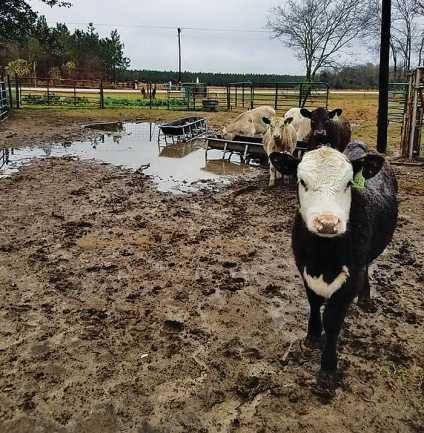
In dairy herds, depending on housing situations, the milking herd may see an increase in incidences of clinical mastitis. This can be traced back to warming temperatures, which can increase pathogen loads in the environment. Producers should monitor somatic cell counts and stay vigilant with their sanitation procedures. Utilize strong sanitation protocols when milking. Prioritize clean teats, fore stripping, and checking for clinical mastitis when appropriate to minimize mastitis risks. For both dairy and beef, providing clean, dry bedding will be beneficial to overall performance.
This article was submitted by Dana Adams, University of Minnesota Extension.
5.5 percent in January 2022 to 11.5 percent this year.
Whey imports totaled 113.7 million pounds, up 52.6 percent from a year ago and have grown in annual comparisons, says HighGround Dairy, but are still lagging the market highs in
2021. The United States is China’s numberone whey supplier, taking a 42 percent market share.
Butter totaled 13.8 million pounds, down 15.1 percent; while anhydrous milkfat, at 4.6 million, was down 41 percent.
Cheese imports amounted to 27.6 million pounds, up 0.1 percent, while infant formula, at 53.6 million pounds, was up 37.4 percent from a year ago.
Conventional product sales totaled 3.5 billion pounds, down 1 percent from a year ago. Organic products, at 258 million pounds, were up 4.8 percent and represented 6.8 percent of total sales for the month.
Whole milk sales totaled 1.3 billion pounds, up 1.2 percent from a year ago, and represented 34.2 percent of total milk sales for the month. Skim milk sales, at 193 million pounds, were down 6.2 percent from a year ago. The figures represent consumption in Federal milk marketing order areas, which account for approximately 92 percent of total fluid milk sales in the United States.
Sales of lactose-free and lowlactose milks are growing even more rapidly than plantbased alternatives. These milks include longstanding brands like Lactaid, as well as the newer ultra-filtered, nutrient-dense, high-protein milks such as Fairlife and to a lesser degree the much newer A2 milks. While technically not low-lactose, A2 milk, which contains only the A2 protein, have been shown to prevent some symptoms for those who suffer from lactose malabsorption.
Lucas Fuess, Rabo Bank senior dairy analyst, shared some insights from Robo’s Global Dairy Quarterly report in the March 27 “Dairy Radio Now” broadcast. He warned of an abundant spring flush in the United States with steep discounts on milk; but said he doesn’t see a lot more near term weakness, “as demand holds up.”
— Daily Dairy Report, March 16
Europe is seeing more milk, he said, and the weak March 21 GDT came even as Chinese demand was “fairly decent. Other buyers did not step up enough to lift those global product prices.”
Fuess expects some price recovery for the United States in the second half of 2023; though he admits it will be a challenge to keep pace with 2022 export records in 2023.
Back home, fluid milk sales looked a little better in January, in that they didn’t fall as much as has been the case. The USDA’s latest data shows packaged fluid product sales totaled 3.8 billion pounds, down just 0.6 percent from January 2022.
One more positive note: the March 16 Daily Dairy Report says, “Sales of lactose-free and low-lactose milks are growing even more rapidly than plant-based alternatives. These milks include longstanding brands like Lactaid, as well as the newer ultra-filtered, nutrientdense, high-protein milks such as Fairlife and to a lesser degree the much newer A2 milks. While technically not low-lactose, A2 milk, which contains only the A2 protein, have been shown to prevent some symptoms for those who suffer from lactose malabsorption.”
Speaking of fluid milk, the USDA announced the April Class I base price at $18.85 per hundredweight. This is down 14 cents from March, $5.53 below a year ago, and the lowest Class I since November 2021. It equates to $1.62 per gallon, down from $2.10 a year ago. The four-month Class I average stands at $20.26, down from $22.15 a year ago, and compares to $15.35 in 2021.
Dairy prices were mixed as spring
MIELKE, from pg. 21
was sprung this week. The cheddar blocks, after pole vaulting almost 22 cents the previous week, made it to $2 per pound on March 22, and closed two days later at $2.10. This is the highest since Jan. 11, up 10.25 cents on the week, but 17.5 cents below a year ago.
The barrels went the other direction after gaining 42 cents the previous three weeks, falling to $1.94 on March 22. They rallied to close March 24 at $1.9625, up a quarter-cent on the week, 28.75 cents below a year ago, and raised the spread to 13.75 cents. Sales totaled 14 cars of block on the week and 19 of barrel.
Midwestern cheesemakers are still finding spot milk as low as $11 under Class III, according to Dairy Market News. There is no shortage of milk in the Midwest, though cheesemakers who had been reporting heavily discounted milk in recent weeks weren’t getting those offers this week. Cheese inventories are balanced to tight. Some cheesemakers are running behind, as demand has returned. Barrel cheese producers suggest similar sentiment.
Varietal cheese demand from retail and food service purchasers is steady in the West. Close to sold out inventories for contract sales continue. Export demand remains strong to steady from Asian markets and more consistent prices holding. Export demand to other areas is reportedly steady to light but less competitive to European and Global Dairy Trading pricing. Ample milk volumes are available for cheesemakers to keep regional cheese production strong, says Dairy Market News.
Cash butter saw its March 24 finish at $2.345 per pound, down 5.5 cents on the week and 45 cents below a year ago, with 11 loads sold on the week.
Butter demand ranges from on par to busy, with some plants saying spring holiday demand has backed off. Certain retailers are still ordering somewhat actively. Butter churning is very active. Cream is available locally, but offers are quieter and some plants were obtaining cream from the West. Organic cream is reportedly widely available, in comparison to conventional cream, says Dairy Market News
Cream volumes are plentiful in the west and demand is steady to light. Some cream was being brought in to keep production at max capacity, while others remain at decreased capacity due to equipment repairs. Retail demand is steady, with spring holiday season orders picking up. Export demand is steady for Asian markets, while lighter for European markets due to less competitive U.S. prices.
CME nonfat dry milk fell to the lowest level it has seen since March 22, 2021, closing at $1.15 per pound, 3.75 cents lower on the week and 70.25 cents below a year ago, with three sales put on the board.
The whey closed March 24 at 44.5 cents per pound, down 2.25 cents on the week and 27.5 cents below a year ago, with five sales on the week at the CME.
Lee Mielke is a syndicated columnist who resides in Everson, Wash. His weekly column is featured in newspapers across the country and he may be reached at lkmielke@juno.com. v
ST. CLOUD, Minn. — One of the largest expenses for a dairy is the feed bill. Each Holstein dairy cow consumes approximately 50 pounds of dry matter daily to meet her milk production needs. Of her total mixed ration, typically 50-60 percent are ensiled forages. Many dairy producers put up silage or baleage after harvest and feed this part of the ration daily without another thought. Just like a silage bunk or bag will differ in moisture or crude protein from year to year, feeding practices and that feed analysis might be worth further examination.
Throughout the year, dairy producers send silage samples to feed labs to better understand the quality of what they are feeding their cows. The nutritive value of the silage coming out of the field is impacted by both crop factors and management factors.
Crop factors which impact the quality of silage include moisture content, buffering capacity, and sugar content. Some common management factors important to monitor during harvest include chop length, silo packing speed, and silage pack density. The silage which has been stored can continue to change over time. To continue feeding high-quality silage, producers should monitor management factors such as silo feed-out and silo management during storage.
In mid-winter, little can be done to alter silage moisture content, chop length, and packing speed. Manage how silage is fed out and the silo itself. Creating and maintaining an anaerobic (no oxygen) environment with low pH limits the activity and growth of spoilage organisms. However, exposure to even a small amount of oxygen allows yeast to grow.
Yeast converts organic acids and residual plant sugars to carbon dioxide, water and heat. This results in silage pH increasing which allows bacteria, yeast and molds once inhibited by the acidic environment, to grow. These organisms consume nutrients and produce heat.
To collect the highest quality silage from a silo or bag, the daily removal rate must be kept ahead of aerobic spoilage. This delicate balance can be navigated by sizing storage structures to forage needs. The removal rate is determined by environmental temperatures and the density of the silage mass, which affects the rate at which air permeates the forage.
Silage quality requires constant vigilance. What arrives at the dairy cow’s bunk is a combination of forages produced during the growing season, management steps during ensiling, and stored silage management practices. To keep quality at its best, there are some key steps which need to be performed.
All exposed surfaces of the silage mass allow oxygen to enter, therefore warranting a plan of attack to maintain silage quality. Properly packing and sealing structures limit exposure to oxygen, creating an anaerobic environment, and limiting loss during storage. Once silage is collected from the silo and is exposed to oxygen, it begins to heat and spoil. The time it takes for this to occur is referred to as anaerobic stability. Anaerobic stability can be affected by spoilage organism populations, temperature, forage dry matter, or forage species to name a few.
Management of the silage face is also extremely
important due to its exposure from the time the bunk is opened until it is emptied. Minimizing oxygen exposure can be accomplished by evenly removing silage from the face, and maintaining a smooth vertical surface perpendicular to the ground.
Silage quality can vary throughout a pile or throughout a bag. Regular silage testing allows producers to know, rather than guess, if what the TMR is providing. Typically, a lab’s fermentation analysis can be a more in-depth look into that feed and what level of fermentation has occurred. In some cases, it can qualitatively explain the poor nutritive value, high refusals, and therefore low intakes by the herd. A fermentation analysis should not be relied on alone, but paired with a standard chemical analysis. Fermentation analysis may be used in identifying intake or performance issues. Feed and fermentation analysis can be used as a tool for making management decisions.
Silage management is a marathon and not a sprint. It requires a strong start composed of appropriate chop length, silo packing speed, and silage pack density during ensiling. To maintain that high quality silage, strong silage management also requires maintaining an anaerobic environment through minimizing oxygen exposure to the pile or bag face. Starting with a quality silage, mindfully maintaining the silage face and regular sampling work together to allow producers to keep their ration on track and reach the herds’ potential.
This article was submitted by Dana Adams, University of Minnesota Extension.
Announcements
Reminder...
Get one FREE classified line ad if you return your 2023 LAND subscription card. Call us at 507-345-4523 for more details. Thank you for reading THE LAND!
Real Estate
FOR RENT: 20 acre horse pasture w/ creek/trails, barn & house also. Kimball area 320-221-1872
Real Estate Wanted
WANTED: Land & farms. I have clients looking for dairy, & cash grain operations, as well as bare land parcels from 40-1000 acres. Both for relocation & investments. If you have even thought about selling contact: Paul Krueger, Farm & Land Specialist, Edina Realty, 138 Main St. W., New Prague, MN 55372. paulkrueger@edinarealty.com


(612)328-4506
Feed Seed Hay
Hay for sale: Big Square 3x3x8 Grass/Alfalfa. $100 each 5+$95. 4x5 rounds $90, 5+$85. Mostly 2nd of 3 crops. Stored inside no rain. Delivery available up to semi load. Discounts available. Owatonna. 507-213-0560. Also Certified Seed Potatoes For Sale. Souba Greenhouse
OPEN Pollinated Seed Corn. Produces more high quality silage on less acres than hybrid. $67/bushel plus shipping. High feed value grain. borriesopenpollinatedseedcorn.com 217-857-3377 or 217-343-4962
Fertilizer & Chemical
Glyphosate 5.4 totes, $20.95 Gen Liberty totes, $44.95; Enlist 1 totes, $46.95. Surestart 2 totes, $44.95. We ship most everywhere & all tote prices include Free Delivery to your farm or business. Please call or text for any other chemical needs. Phone 612-210-3685
Bins & Buildings
SILO
Take-down & clean up
Specializing in silos in congested areas. FULLY
Stormor Bins & EZ-Drys. 100% financing w/no liens or red tape, call Steve at Fairfax Ag for an appointment. 888-830-7757
72” skidloader snowblower, exc cond, $5,795; 1830 Case IH 12R30” row cultivator, $6,750; Case IH 5300 grain drill 24’ tandem unit, $7,500; Rock Bucket for skidloader, 78”, $1,095. 507-240-0294
FOR SALE: JD 7000 planter, 8R w/ bean cups, w/ JD monitor 200 Series; Century Hiniker sprayer, 45’ hyd fold boom, w/ Hiniker 8160 monitor & foam markers; Hiniker 1000 8R cult; JD 960 field cult, 23 1/2 ft. 507-317-5966
Tuesday, April 11th - 11:00 am
Auction held at: Gaylord American Legion 329 Main Ave, Gaylord, MN 55334

Here is your chance to own easily accessible farmland in Sibley County. This land has been in the Witt family for 75 years, thoroughly tiled and highly productive. Do not miss this rare opportunity!
Location of property within Sibley County: Sibley Township, Section 4, Range 28 This property will sell as one parcel: 145.5 total acres, approx. 141.53 acres tillable.
Productivity Index: 87
*Note: All acres are published based on Sibley County Online Records & FSA records. In case of severe weather, listen to 860 AM KNUJ & 107.3 FM SAM 8:30 the morning of the auction for postponement & rescheduling info. Blizzard Date is April 13th ~ 11:00 am
Listing Auctioneers: Ryan Froehlich ~ 507-380-9256 & Joe Maidl ~ 507-276-7749
Auctioneers: Matt Mages Lic 52-22-018, Larry Mages, Joe Wersal, Joe Maidl, John Goelz, & Ryan Froehlich
Broker/ Clerk: Mages Land Co. & Auction Service, LLC. Not responsible for accidents at auction or during inspection. Everything sold “AS IS”. Everything to be settled immediately after the auction. For all full terms and bidding go to magesland.com. magesland.com
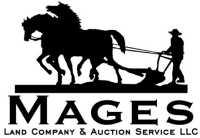
To submit your classified ad

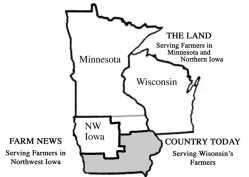
NOTE: Ad will be placed in the appropriate category if not marked.
FOR SALE: 2013 Kubota
F3080 front mount lawn mower, 3 cyl. 30HP dsl, 4WD, hydro, 1479 hrs, 60” tilt up fabricated deck, steering wheel steer, bought new, nice!! $10,750. 507-440-1990
FOR SALE: NH T4-75 tractor loader, 4x4, CAH, 1000 hrs, $39,900; JD 6430, premium, loaded, $44,900; NH LX665 skid loader, new tires & bucket, $15,900 Best offer or trade. 612-719-6524
FOR SALE: 1980 8820 combine with dual wheels, tires like new, with rear wheel assist, last 5 yrs $12,000 on repairs. asking $10,000. 507-391-5127
FOR SALE: 8x53 10HP electric auger on transport; also 8x53 PTO auger on transport; also gravity box on running gear. 701-412-8910
Sell your farm equipment in The Land with a line ad. 507-345-4523

FOR SALE: Brett 880 grain cart w/ tarp, nice shape, $26,900. Located at C&D Equipment near Edgerton MN. Call Tim at 815-988-2074
JD 2210 27.5’ field cult w/ single point depth & 3 bar harrow, $25,750; JD 520 20’ 3pt drill,
10” spacing w/ markers, $4,900; 2012 Unverferth 165
40’ rolling harrow, $11,900; Case IH 183 12x30 vibra tine flat fold cult, $1,950; NH 650
4’x6’ round baler, twine tie, exc cond, $4,900. 320-769-2756 or 320-361-0065 cell.
We buy Salvage Equipment
Parts Available
Hammell Equip., Inc. (507)867-4910
White 6122 12R30” liquid
$8,500; HD 10’ Sovema 3pt tiller, $6,500; Older Dagelman rock picker, $900; 6-JD
10” ripper points at 75%, $450/all; 4 front disc, complete assemblies for JD 2700 ripper; $300/ea. 952-212-3328
Tractors
FOR SALE: JD 8640, 2640 hours, 3pt, PTO, Rock Box, New cab interior, very well maintained, always shedded, always been on a small farm. $31,000. 507-213-0600
NEW AND USED TRACTOR
PARTS JD 10, 20, 30, 40, 50, 55, 50 Series & newer tractors, AC-all models, Large Inventory, We ship! Mark Heitman Tractor Salvage 715-673-4829
FOR SALE: 2006 Rogator 1074 SP sprayer, 3900 hrs, 1100 gal S/S tank, 80/90’ booms, 3 way nozzles, Raven SCS 4000 monitor, 5 shutoffs, JD ATU, very nice, $45,000. Road Boss 24’ triple axle trailer w/ 2000 gal tank, pump, inductor & chemical tanks. Both always shedded. Must see. Lamberton MN 507-828-1963
Please recycle this magazine.
FOR SALE: 3 - 4516 Meyer forage boxes w/ tandem running gear, good condition, always shedded. Near Altura, MN. 507-208-8310
FOR SALE: Stainless steel fence line dry hog feeders, many sizes. 507-383-7858
Albert Lea, MN
All kinds of New & Used farm equipment - disc chisels, field cults, planters, soil finishers, cornheads, feed mills, discs, balers, haybines, etc. 507438-9782
WANTED: Late model FarmFans or Super B 12’ AB/CF dryer, w/ low hours/LP. 763-301-4245 please leave message.
TRACTORS
NEW NH T4.75, T4.90, T4.120 w/loader On Order
NEW NH Workmaster 60, 50, 35’s/loaders On Order
NEW NH 25S Workmasters ...…......…. On Order
NEW Massey Tractors ........................... On Order
NEW Massey 4710 w/loader ….......... COMING
NEW NH Boomer 40w/loader ….......… On Hand
3-New Massey GC1725 ……..................... Just In
’16 Massey 4608 rops w/loader …............. $43,900
’11 Massey 7475 Nice ………............……. SOLD
Massey 1652/cab/loader …….......………. $37,900
NH 8970 ………………….....…...……… $58,500
’21 NH T7.260 ………............………… $169,000
’18 NH Boomer 55/cab/loader ……......… $43,000
’18 NH T4.75 w/loader .............................. $54,000
’17 NH T4.75 w/loader ……..................… $53,000
’13 NH Workmaster 35w/loader ……...…. $18,500
Bobcat CT440 w/loader ……........… $16,900
Kubota/cab/loader …….....................…… $29,500
TILLAGE
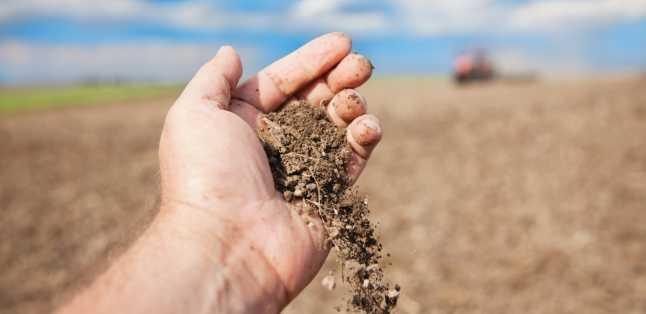
Sunflower 4610 9-24 …….............…… COMING
DMI Tigermate II 46.5 w/bskt ….....….…. $32,000
DMI Tigermate II 36.5 w/4bar ….....….…. $22,000
DMI Tigermate II 40.5 w/3bar ….…......… $25,900
CONSTRUCTION EQUIPMENT

NEW NH L318/L320/L328 wheeled units ....... On Hand
NEW NH C327/C337/C345 track units .......... On Order
NH L228 low hours ............................................ $44,900
HAY TOOLS
New Disc Mowers - 107,108,109
New Disc Mower Cond. - 10’, 13’
New Wheel Rakes - 10,12,14
New NH Hay Tools - ON HAND
Frontiern WR1010 wheel rake …….............……… $5,950
PLANTERS
JD 7200 12-30 w/LF ………........................…… $21,000 White 6186 16-30 w/liq …....…...................……. $15,900
Price chg White 6186 …….........………………. $12,000
’12 White 8222 w/liq ……………...……………. Just in Taking 2023 New Spring Orders




COMBINES
NEW Geringhoff chopping cornhead Call ’02 Gleaner R62 …...............................……… $53,500
’02 Gleaner R62 ……………...................……. $35,000
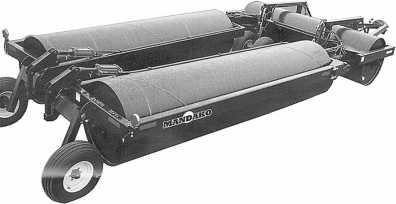

’94 Gleaner R72 ………….......................…… $27,000 Gleaner R65 ……...............................…….. COMING
Geringhoff parts & heads available
MISCELLANEOUS
NEW Salford RTS Units ........................................ Call NEW Unverferth Seed Tenders .............................. Call NEW Westfield Augers .......................................... Call NEW REM VRX Vacs. .......................................... Call NEW Hardi Sprayers ............................................. Call NEW Riteway Rollers ........................................... Call NEW Lorenz Snowblowers ................................... Call NEW Batco Conveyors ......................................... Call NEW Brent Wagons & Grain Carts ....................... Call NEW E-Z Trail Seed Wagons ................................ Call NEW Rock Buckets & Pallet Forks ...................... Call Pre-Owned Grain Cart .................................. On Hand New Horsch Jokers
Please support our advertisers. Tell them you saw their ad in THE LAND.



Talk
WANTED: John Deere no till drill, model 1590 or 750. Must be 20’, in good to excellent condition. Call 507-404-0580
FOR SALE: Black Angus bulls also Hamp, York, & Hamp/ Duroc boars & gilts. Alfred (Mike) Kemen 320-598-3790
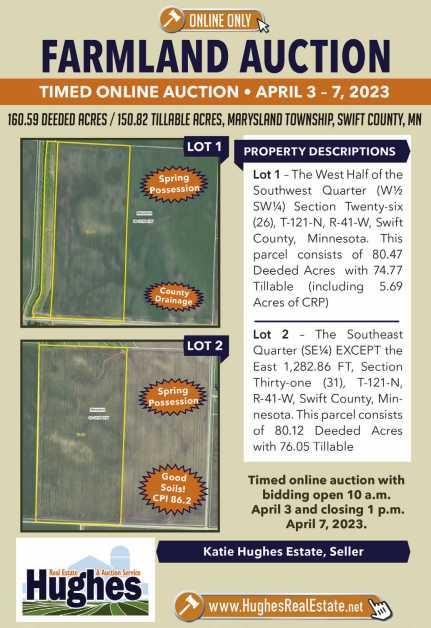
Sell
The Land
Cattle
Registered Polled Hereford yearling bulls for sale. Have had all shots, poured and semen tested. Halter broke and broke to lead.
Fantastic growth EPD’s!
Will deliver. Klages Herefords, Ortonville, MN. 320-273-2163(H) 605-8800521(C)
Swine
FOR SALE: Yorkshire, Hampshire, Duroc, cross bred boars, and gilts. Top quality. Excellent herd health. No PRSS. Delivery available. 320-760-0365
Spot, Duroc, Chester White, Boars & Gilts available. Monthly PRRS and PEDV. Delivery available. Steve Resler. 507-456-7746 Miscellaneous

PARMA DRAINAGE PUMPS New pumps & parts on hand. Call Minnesota’s largest distributor
HJ Olson & Company 320-974-8990 Cell - 320-212-5336

AKC REG. COCKER SPANIEL
PUPS: Big Litters! 1/2 PRICE! 2-M, 5-F shots & wormed. 920-563-3410 mornings (#268588)(mcn)
CASH FOR CARS! We buy all cars! Junk, high-end, totaled – it doesn’t matter! Get free towing and same day cash! NEWER MODELS too! Call 1-877-978-2510. (mcn)
DONATE YOUR CAR TO CHARITY. Receive maximum value of write off for your taxes. Running or not! All conditions accepted. Free pickup. Call for details. 855-752-6680 (mcn)
Donating your vehicle? Get more! Free Towing. Tax Deductible. Plus a $200 restaurant voucher and a 2-night/3-day hotel stay at one of 50 locations. Call Heritage for the Blind to donate your vehicle today - 1-855-977-7030. (mcn)
FREE high-speed internet for those that qualify. Government program for recipients of select programs incl. Medicaid, SNAP, Housing Assistance, WIC, Veterans Pension, Survivor Benefits, Lifeline, Tribal. 15 GB internet service. Bonus offer: Android tablet FREE with one-time $20 copay. Free shipping & handling. Call Maxsip Telecom today! 1-866-443-3789. (mcn)
BEST SATELLITE TV with 2 Year Price Guarantee! $59.99/mo with 190 channels and 3 months free premium movie channels! Free next day installation! Call 855-824-1258. (mcn)
DirecTV Satellite TV Service Starting at $74.99/month! Free Installation! 160+ channels available. Call Now to Get the Most Sports & Entertainment on TV! 844-558-1767 (mcn)
DISH Network. $64.99 for 190 Channels! Blazing Fast Internet, $19.99/ mo. (where available.) Switch & Get a FREE $100 Visa Gift Card. FREE Voice Remote. FREE HD DVR. FREE Streaming on ALL Devices. Call today! 1-855-434-0020 (mcn)
Get DIRECTV for $84.99/mo for 24 months with CHOICE Package. NEW 2 YEAR PRICE GUARANTEE. First 3 months of HBO Max, Cinemax, Showtime, Starz and Epix included! Directv is #1 in Customer Satisfaction (JD Power & Assoc.) Some restrictions apply. Call 1-866-296-1409. (mcn)
Connect to the best wireless home internet with EarthLink. Enjoy speeds from 5G and 4G LTE networks, no contracts, easy installation, and data plans up to 300 GB. Call 844-878-2209. (mcn)
Dish Network: Only from Dish3-year TV Price Guarantee! 99% Signal Reliability, backed by guarantee. Includes Multi-Sport with NFL Redzone. Switch and Get a FREE $100 Gift Card. Call today! 1-855-434-0020. (mcn)
Worthing SD is hiring a full-time Utility Maintenance person with full benefits. Responsibilities include working in the city’s water, sewer, streets, and park departments. Information can be found at www.cityofworthing.com. (mcn)
The COVID crisis has cost us all something. Many have lost jobs and financial security. Have $10K In Debt? Credit Cards. Medical Bills. Car Loans. Call NATIONAL DEBT RELIEF! We can help! Get a FREE debt relief quote: Call 1-866-552-0649.(mcn)
Portable Oxygen Concentrator May Be Covered by Medicare! Reclaim independence and mobility with the compact design and long-lasting battery of Inogen One. Free information kit! Call 844-716-2411. (mcn)
DENTAL INSURANCE from Physicians Mutual Insurance Company. Coverage for 350 plus procedures. Real dental insurance- NOT just a discount plan. Do not wait! Call now! Get your FREE Dental Information Kit with all the details! 1-855-973-9175 www.dental50plus.com/https://www. dental50plus.com/midwest #6258 (mcn)
Don’t let the stairs limit your mobility! Discover the ideal solution for anyone who struggles on the stairs, is concerned about a fall or wants to regain access to their entire home. Call AmeriGlide today! 1-877-916-2093. (mcn)
Stroke and Cardiovascular disease are leading causes of death, according to the American Heart Association. Screenings can provide peace of mind or early detection! Contact Life Line Screening to schedule your screening. Special offer - 5 screenings for just $149. Call 1-866742-7290. (mcn)
Vivint. Smart security. Professionally installed. One connected system for total peace of mind. FREE professional installation! Four FREE months of monitoring! Call now to customize your system. 1-855-962-5554. (mcn)
DIAGNOSED WITH LUNG CANCER? You may qualify for a substantial cash award - even with smoking history. NO obligation! We’ve recovered millions. Let us help!! Call 24/7, 1-888-490-8260. (mcn)
BATH & SHOWER UPDATES in as little as ONE DAY! Affordable pricesNo payments for 18 months! Lifetime warranty & professional installs. Senior & Military Discounts available. Call 1-866-585-7073. (mcn)
LONG DISTANCE MOVING: Call today for a FREE QUOTE from America’s Most Trusted Interstate Movers. Let us take the stress out of moving! Speak to a Relocation Specialist, call 877-327-0795. (mcn)
BATHROOM RENOVATIONS. EASY, ONE DAY updates! We specialize in safe bathing. Grab bars, no slip flooring & seated showers. Call for a free in-home consultation: 855-8362250. (mcn)
NEED NEW FLOORING? Call Empire Today® to schedule a FREE inhome estimate on Carpeting & Flooring. Call Today! 844-785-0305 (mcn)
Never clean your gutters again! Affordable, professionally installed gutter guards protect your gutters and home from debris and leaves forever! For a FREE Quote call: 877-761-1449 (mcn)
The Generac PWRcell, a solar plus battery storage system. SAVE money, reduce your reliance on the grid, prepare for power outages and power your home. Full installation services available. $0
Down Financing Option. Request a FREE, no obligation, quote today. Call 1-877-381-3059. (mcn)
Prepare for power outages today with a GENERAC home standby generator.
$0 Money Down + Low Monthly
Payment Options. Request a FREE
Quote. Call now before the next power outage: 1-877-228-5789 (mcn)
Eliminate gutter cleaning forever! LeafFilter, the most advanced debrisblocking gutter protection. Schedule a FREE LeafFilter estimate today. 20% off Entire Purchase. Plus 10% Senior & Military Discounts. Call 1-855-5771268. (mcn)
Become a Published Author. We want to Read Your Book! Dorrance PublishingTrusted by Authors Since 1920. Book manuscript submissions currently being reviewed. Comprehensive Services: Consultation, Production, Promotion and Distribution. Call for Your Free Author`s Guide 1-877-516-0706 or visit dorranceinfo.com/Midwest (mcn)
Wesley Financial Group, LLC Timeshare Cancellation Experts. Over $50,000,000 in timeshare debt and fees cancelled in 2019. Get free informational package and learn how to get rid of your timeshare! Free consultations. Over 450 positive reviews. Call 877-326-1608. (mcn)
Trouble hearing your TV? Try TV EARS Voice Clarifying Wireless TV Speaker. Better than a soundbar and/or turning the TV volume way up. Special, limited time $50 off offer. Call TV Ears. Use code MBSP50. Call 1-844-4550505. (mcn)
Safe Step. North Americas #1 WalkIn Tub. Comprehensive lifetime warranty. Top-of-the-line installation and service. Now featuring our FREE shower package and $1600 Off for a limited time! Call today! Financing available. Call Safe Step 1-844-2905083. (mcn)
Switch and save up to $250/year on your talk, text and data. No contract and no hidden fees. Unlimited talk and text with flexible data plans. Premium nationwide coverage. 100% U.S. based customer service. Limited time offer! Get $50 off on any new account. Use code GIFT50. For more information, call 1-888-909-7338. (mcn)
Are you a pet owner? Do you want to get up to 100% back on Vet Bills? Physicians Mutual Insurance Company has pet coverage that can help! Call 1-888-680-3016 to get a free quote or visit mfcp. (mcn)
PAYING TOP CA$H FOR MEN’S SPORT WATCHES! Rolex, Breitling, Omega, Patek Philippe, Heuer, Daytona, GMT, Submariner, Speedmaster.. Call: 866-314-9742. (mcn)
TOP CA$H PAID FOR OLD GUITARS! 1920-1980 Gibson, Martin, Fender, Gretsch, Epiphone, Guild, Mosrite, Rickenbacker, Prairie State, D’Angelico, Stromberg. And Gibson Mandolins / Banjos. 866-470-1643. (mcn)
Wanted: Antique Bicycles from 1930’s-50’s. Deluxe or unusual models with horn tanks, headlights, etc. Also buying Schwinn Stingray bikes from 1960’s-70’s. Top prices paid. Will pick up anywhere. 309-645-4623. (mcn)
Buying and selling silver bars, silver dollars, rare coins, gold coins, gold jewelry, any gold-silver items, collector coins. Kuehl’s Coins, Fairmont, Minnesota, 507-235-3886. (mcn)


In the early 1960s, when Minnesota planned to build a college in southwest Minnesota, the city of Fairmont purchased a 40-acre homestead on the west side of town as part of their bid for the institution. Marshall won out as the college location, but that land was still destined to be an educational center.
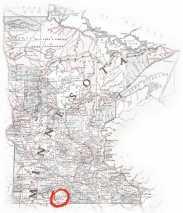
In 1976, a group of folks who saw the swiftlychanging farm scene, realized that soon younger generations would have no idea of how farming had once been. The result of that concern is Heritage Acres Agricultural Interpretive Center.
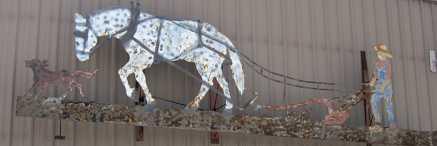
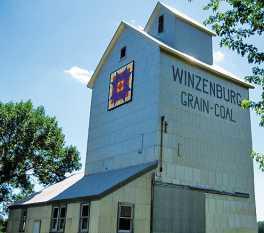
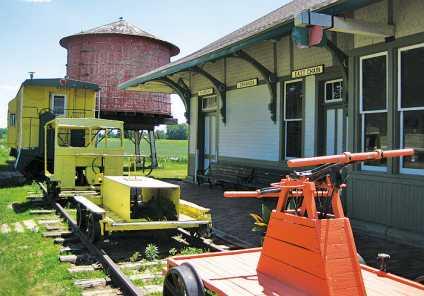
The barn is the only original building from the Reuben Ward homestead. A volunteer group runs the non-profit organization. They started an annual music festival to draw people to the grounds.

“The first music festivals on the Fourth of July were outside up by the barn and house,” said Jerry Simon, current president of the board of directors. “There were no other buildings here [at the time]. Then the church, the school, and the elevator all show up by truck.”
The festivals expanded beyond the Fourth of July with the addition of a Threshing Day and a Fall Festival (though Covid and a lack of volunteer help have put a strain on that). The number of buildings expanded even more. There is now a granary, chicken house, windmill, silo, log cabin, and blacksmith shop. In front of the depot (from Welcome, Minn.) is a track with a caboose, and railroad crew maintenance cars. The railroad mainte-
nance cars were manufactured in Fairmont in the early 1900s.
Heritage Acres has added a third pole building to store all of the machinery and items they have received. One building houses Prairieville Mall. Rather than create a Main Street with numerous small buildings, the Mall is a 1940s Main Street of business facades constructed inside — each business filled with related artifacts.
Heritage Acres has a volunteer board, but anyone is welcome to donate time and run for the board. The organization farms the 22 tillable acres with corn, beans and oats using older machinery (of which they have plenty). Retired farmers basically outfitted the place, Simon said. “They wanted to have a place for their old machinery to educate the young kids how things were done in the past.” Two acres are set aside for public gardens for which individuals sign up to cultivate.
Since this is city-owned land, the public has access much like a park. The buildings, however, are only open during Heritage Acres festivals and by appointment. They encourage bus tours and tours of school children. The church building can be rented for weddings.

Heritage Acres is located at 507 West Lake Avenue in Fairmont, on the west side of Lake Sisseton.

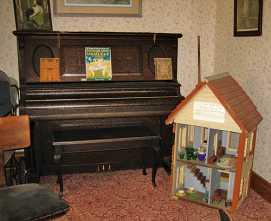
For tours and rental information, call Simon at (507) 238-4645. Visit their Facebook page, HeritageAcresFairmont. v




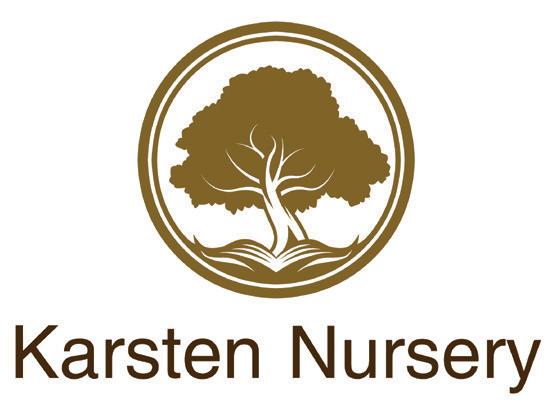
Karsten Nursery has been in the tree business for over 40 years, originally specializing in bareroot wind-breaks. Now, they have established an effective, fast-growing windbreak with its Hybrid SuperTree™. The hybrid is a cross between the Chinese Willow and the White Willow, and is sold to Midwest farmers and ranchers primarily for windbreaks.
The Hybrid SuperTree™ stands out from other windbreak species due to its growing speed & strength. Both traits mean they can act as a windbreak within 3 years of planting. Joel Karsten of Karsten Nursery says “In some parts of the country, these trees will grow 10 to 14 feet per year, but in our shorter growing season here in Minnesota, we see 6 to 8 feet per year.” The photo at the top of this page shows a row of Hybrid SuperTree™ planted six feet apart after 50 months of growth. Average height is 35’ and width is 15-20’. Hardy down to the cold of zone 3, and up to zone 10, this hybrid tree is sold all over the USA, and grows well in all climates.
HYBRID SUPERTREES™ are a unique cross that grows extremely quickly, usually reaching 18-20’ often within two years of planting, and yet maintains structural integrity to allow it to reach a mature height of 50 - 70 feet if left without any pruning. The width can reach 15-17’ but can easily be controlled by pruning. This cultivar is disease resistant and has no known insect problems that affect the overall growth habit. It grows well in many different soil types, from sandy
to clay soils, however the most important requirement is moisture. If water is provided weekly during the first year after planting, the root system will easily support the tree after that, unless drought conditions occur. This tree seems to have a lifespan of around 30 years but they do begin to decline at about 18-20 years old. Other internet sellers will say they live longer, but we have over 500 of these that are 28 year old trees at our nursery, and the trunk diameter is about 30” on average. They began to have broken branches and decline at about 18 years old, and now we are about to remove them and replant. Don’t believe it when others tell you they live 70 years, it is just not true.
We have a Minnesota Nursery and Landscape Association Certified Nursery Professional on staff, and the owner has extensive experience in nursery production for more than 40 years.
Many past customers have returned year after year to purchase additional stock and have always found the finest quality and lowest prices around. We are normally a wholesale business, however over the years retail customers looking for good prices, and willing to order in our minimum bundle quantities have used Karsten Nursery as a great source of trees, shrubs and conifers at a very good value.
Other trees can take 30 years to give you shade and provide a visual barrier from unsightly views. If you need a fastgrowing hedge row that will provide quick protection from wind, snow, noise or dust then order online today and get your Hybrid SuperTrees in the ground soon! We encourage you to plant a variety of other species inside of the outside row of Hybrids, so that in 20 years you will have a good stand of trees inside of the declining row of Willows.

*Caution: Avoid purchasing Hybrid trees from nurseries or online sellers who offer them BARE-ROOT. The death loss percentage is very high (35%+) because the Salix species DOES NOT like to be bare-rooted, and tend to die in high percentages. This means extra work for you even if the seller replaces the dead ones. If one tree in a row dies, you’ll have an open space in your row that is difficult to fill in. The new replacement will be very small and the others grow very quickly. Remember 35% of those replacements will also die, and so on. Our stock is sold as rooted plugs, so the soil COMES WITH enclosing the roots, this way they are never exposed to the air. OUR STOCK will NOT die if given even basic care. Other species of trees grow well from bare-root stock, but NOT the Salix species. OUR STOCK can be planted anytime during the year while bare-root stock should only be sold/planted during the early spring. We used to sell these Hybrids bare-root, but we stopped 22 years ago and developed a better method that really works. Don’t get fooled by low prices, you will be sorry.
For more information on our Hybrid SuperTrees™ or any of our other 100 species of trees, or to order online, please visit www.KarstenNursery.com, or call 651-470-2096
“I bought about 20 or so of your willows just a few years ago. I wanted some privacy from the street at our home. I will say I am very happy with the willows. First off, they all survived and they are looking great. We live in Michigan and winters can be tough but these willows are doing fine. These pictures are from summer of 2019. Glad I found your trees.”
– Christopher E“The SuperTree Hybrid Willows we purchased last spring are already providing us with a privacy screen and shade. Our neighbors are amazed that we have gotten nearly 12 feet of growth already since we planted them.”


 – Mike L. - Sioux Falls, SD
– Mike L. - Sioux Falls, SD
“These hybrids were the only trees in this area that survived the derecho unscathed, while most other trees were leveled.”
– Crystal J. - West of Cedar Rapids, IA“Every single one of the 250 SuperTrees I purchased last spring made it through the winter and are still growing like weeds. It won’t be long now until we cannot see our neighbor’s ugly backyard.”
– John W. - Sibley, IA
